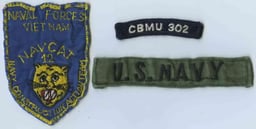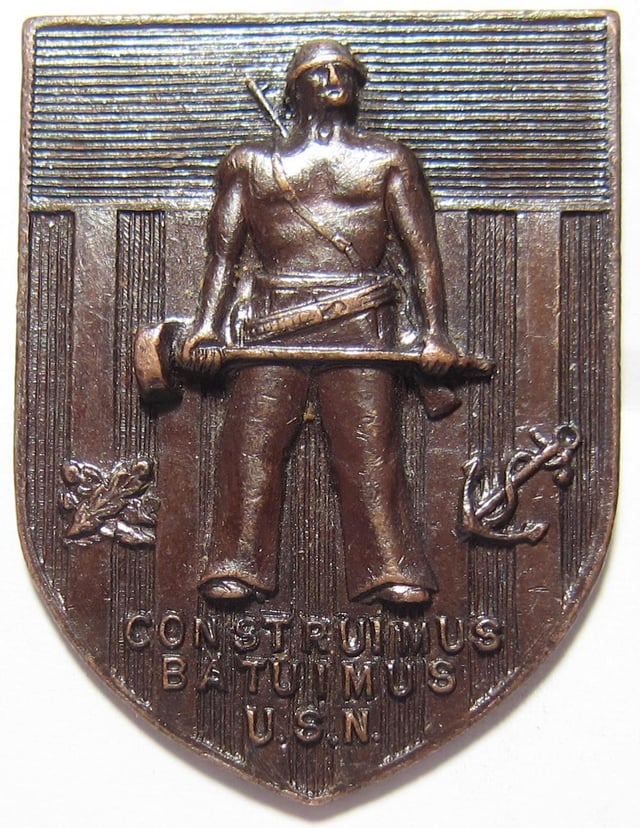Seabee
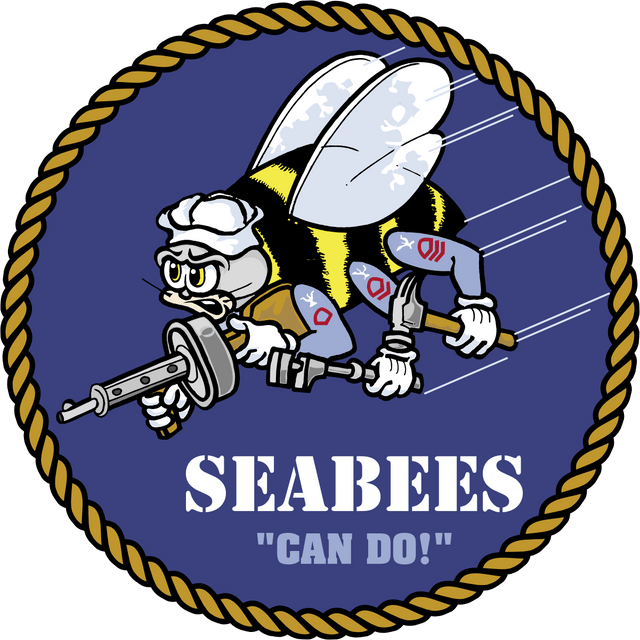
Seabee

| Naval Construction Battalions | |
|---|---|
| Branch | |
| Role | Militarized construction |
| Size |
|
| Nickname(s) | Seabees |
| Motto(s) |
|
| Colors | Flag of the United States Navy (1864–1959) |
| Mascot(s) | The Seabee |
| Anniversaries | 28 December 1941 requested 5 March 1942 authorized |
| Engagements | Guadalcanal, Bougainville, Los Negros, Tarawa, Guam, Peleliu, Saipan, Tinian, Iwo Jima, Okinawa, Normandy, Khe Sanh, Dong Xoai, Chu Lai, Con Thien, Inchon, Desert Storm and Enduring Freedom |
| Website | https://www.public.navy.mil/seabee/Pages/default.aspx [357] |
| Commanders | |
| Notable commanders | Admiral Ben Moreell |
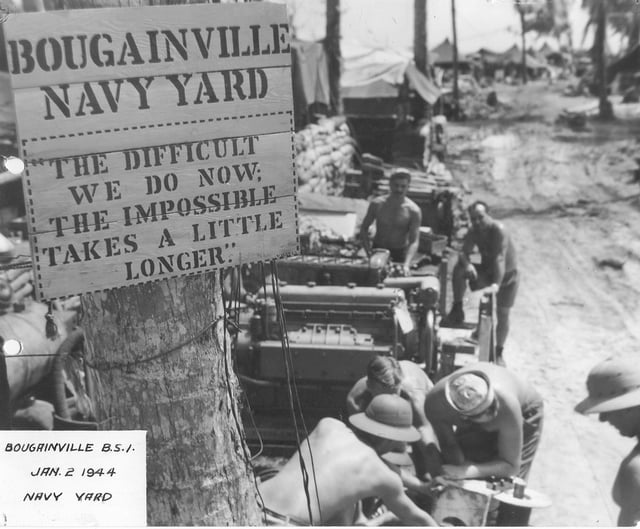
CB Navy Yard Bougainville with the Seabee Expression (Seabee Museum)
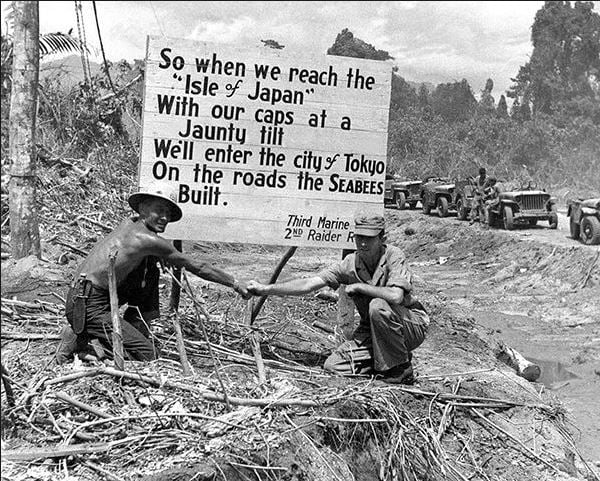
3rd Marine Division, 2nd Raider's sign on Bougainville. 53rd NCB was the shore party to the 2nd Raiders of Green Beach, D-Day (Seabee Museum).
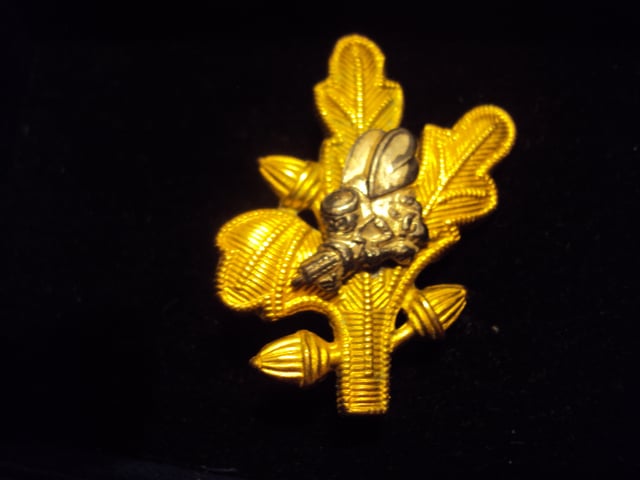
Supply Corps Insignia
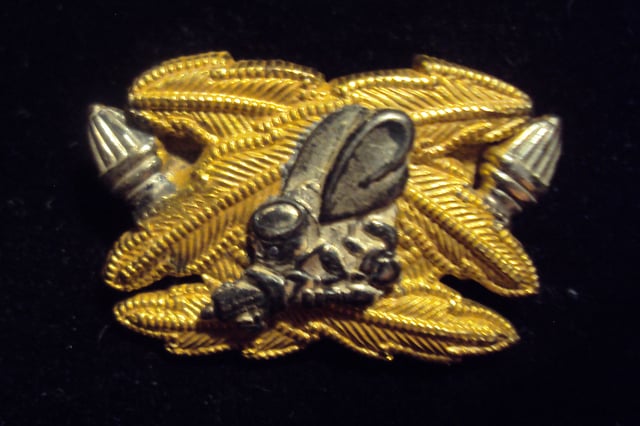
CEC Insignia
United States Naval Construction Battalions, better known as the NavySeabees, form the U.S. Naval Construction Force (NCF). Their nickname is a heterograph of the initials "C.B." from the words Construction Battalion.[1][2] Depending upon how the word is used "Seabee" can refer to one of three things: all the enlisted personnel in the USN's occupational field 7 (OF-7), all officers and enlisted assigned to the Naval Construction Force (NCF), or the U.S. Navy's Construction Battalions (CBs). Seabees also serve outside the NCF. During WWII Seabees served in both the Naval Combat Demolition Units and the Underwater Demolition Teams (UDTs) as well as Cubs, Lions, Acorns and the United States Marine Corps.[3] Today they can be found in many special task assignments, including the Naval Support Unit – Department of State, Camp David, many base Public Works, under both Commanders of the Naval Surface Forces Atlantic/Pacific fleets and USN diving commands.
Naval Construction Battalions were conceived of as a replacement for civilian construction companies working for the U.S. Navy after the United States was drawn into World War II with the Japanese attack on Pearl Harbor on 7 December 1941. At that time the U.S. had roughly 70,000 civilians working on military installations overseas.[4] International law made it illegal for them to resist enemy attack, as to do so would classify them as guerrillas, for which they could be summarily executed,[5] which is exactly what happened when the Japanese invaded Wake Island.[6]
Admiral Moreell's concept model of CBs was that of a USMC–trained battalion of construction tradesmen (a military equivalent of those civilian companies) that would be capable of any type of construction, anywhere needed, under any conditions or circumstances.[7][8] It was quickly realized that this model could be utilized in every theater of operations, as it was seen to be flexible and adaptable. The use of USMC organization allowed for smooth co-ordination, integration or interface of both the NCF and Marine Corps elements. In addition, Seabee Battalions could be deployed individually or in multiples as the project scope and scale dictated. What distinguishes Seabees from Combat Engineers are the skill sets. Combat Engineering is but a sub-set in the Seabee toolbox. They have a storied legacy of creative field ingenuity, stretching from Normandy and Okinawa to Iraq and Afghanistan. Admiral Ernest King wrote to the Seabees on their second anniversary, "Your ingenuity and fortitude have become a legend in the naval service."[9] Seabees believe that anything they are tasked with, they "Can Do" (the CB motto). They were unique at conception and remain so today. In the October 1944 issue of Flying magazine, the Seabees are described as "a phenomenon of World War II".[10] In 2017, the Seabees celebrated their 75 years of service without having changed from Admiral Ben Moreell's conceptual model.
| Naval Construction Battalions | |
|---|---|
| Branch | |
| Role | Militarized construction |
| Size |
|
| Nickname(s) | Seabees |
| Motto(s) |
|
| Colors | Flag of the United States Navy (1864–1959) |
| Mascot(s) | The Seabee |
| Anniversaries | 28 December 1941 requested 5 March 1942 authorized |
| Engagements | Guadalcanal, Bougainville, Los Negros, Tarawa, Guam, Peleliu, Saipan, Tinian, Iwo Jima, Okinawa, Normandy, Khe Sanh, Dong Xoai, Chu Lai, Con Thien, Inchon, Desert Storm and Enduring Freedom |
| Website | https://www.public.navy.mil/seabee/Pages/default.aspx [357] |
| Commanders | |
| Notable commanders | Admiral Ben Moreell |
Naval construction history
World War I precursor
In 1917, the Twelfth Regiment (Public Works)[11] was organized at Naval Training Station Great Lakes.[12] When the US entered World War I in April 1917, the Navy had an immediate requirement to expand the Great Lakes Station in order to house, process, and train 20,000 naval recruits, this number would rise to 50,000 by the end of the year.[12] Lieutenant Malachi Elliott, a graduate of the US Naval Academy, was appointed Public Works Officer at Great Lakes on 18 June 1917, at which time about 500 enlisted men had been assigned to the Public Works Department.[12]
Seeing that the department would need to expand with skilled craftsmen, architects, draftsmen, designers, and other professional and technical people, he began to screen incoming recruits with these skills. Finding many, but not enough, he expanded to recruiting civilians outside of the installation, getting many men willing to join the Navy as petty officers, with the understanding that qualified men could later apply for commissions.[12] This allowed the Public Works Department to grow to nearly 600 men by July 1917.
They were organized into the Twelfth Regiment (Public Works), which was essentially the Public Works Department because staff officers could not exercise military command. Lieutenant William C. Davis was appointed commanding officer of the regiment, he exercised military control, but the Public Works Officers exercised technical control.[12]
In October 1917, the regiment began building Camp Paul Jones at San Diego. With its completion, on 30 December 1917, the regiment became "fully operational" with 1,500 men organized into three battalions.[12] By April 1918, the regiment consisted of 2,400 in five battalions. Men were withdrawn for assignments in the US and abroad.
In spring of 1918, 100 men were given special mechanics and ordnance training before being sent to St. Nazaire, France, to assemble Naval Railway Batteries. Later they would join the gun crews and perform combat duties along the railway lines in proximity to the German lines.[12]
The Twelfth Regiment reached its peak strength 5 November 1918; 55 officers and 6,211 enlisted men formed into 11 battalions. However, with the end of the war on 11 November 1918, the regiment gradually faded away by the end of 1918.[12]
CB Conceptual Formation
In the early 1930s, the idea that the Twelfth Regiment pioneered was still in the minds of many Navy Civil Engineers. The planners of the Bureau of Yards and Docks (BuDocks) began providing for "Navy Construction Battalions" in their contingency war plans. In 1934 Captain Carl Carlson's version of the plan was circulated to the Navy Yards, this idea of "Navy Construction Battalions" would later be tentatively approved by Chief of Naval Operations, Admiral William Harrison Standley.
In 1935, Rear Admiral Norman Smith, Chief of BuDocks, selected Captain Walter Allen, the War Plans Officer, to represent BuDocks on the War Plans Board. Captain Allen presented the bureau's concept of "Naval Construction Battalions" to the Board.[13] The concept was later adopted for inclusion in the Rainbow war plans.[12]
A major weakness to this "Navy Construction Battalions" concept was that there would be dual control of the battalions; military control would be exercised by Navy officers while the construction side would be controlled by the Navy Civil Engineer Corps officers. There would be no provision for good military organization and military training, which was felt to be requisite to creating high morale, discipline, and cooperation among the men. The plans also only allowed for the battalions to be formed to build training stations throughout the US and only on completion be moved to forward areas.[12]
Rear Admiral Ben Moreell became the Chief of BuDocks in December 1937, a post he would hold through the war. With tensions rising in both Europe and Asia, authorization was sought, and quickly received, by the United States Congress for expansion of naval shore bases. New construction was started in the Caribbean and Central Pacific in 1939. These were awarded to private construction firms that would perform the work with civilian personnel under the administrative direction of a Navy Officer in Charge of Construction.[12]
World War II

The Naval Infantry Battalion Flag was mandated by Naval Regulation as the military colors for the Construction Battalions.[14] (U.S. Navy)
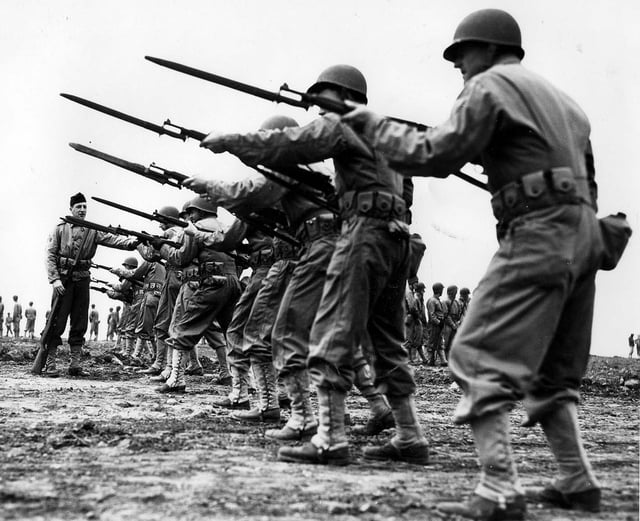
USMC directed fixed bayonet drill at Camp Peary NTC, VA in 1943 (Seabee Museum)

Fleet Marine Force Combat Operation Insignia for Seabees and Corpsmen.[35]
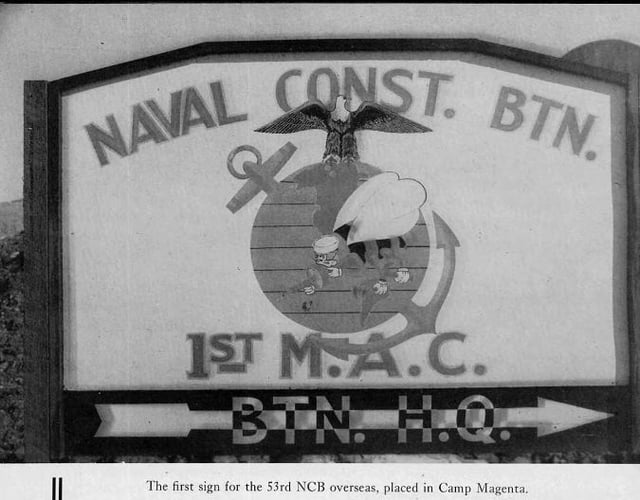
53rd Naval Construction Battalion sign. (Seabee Museum)
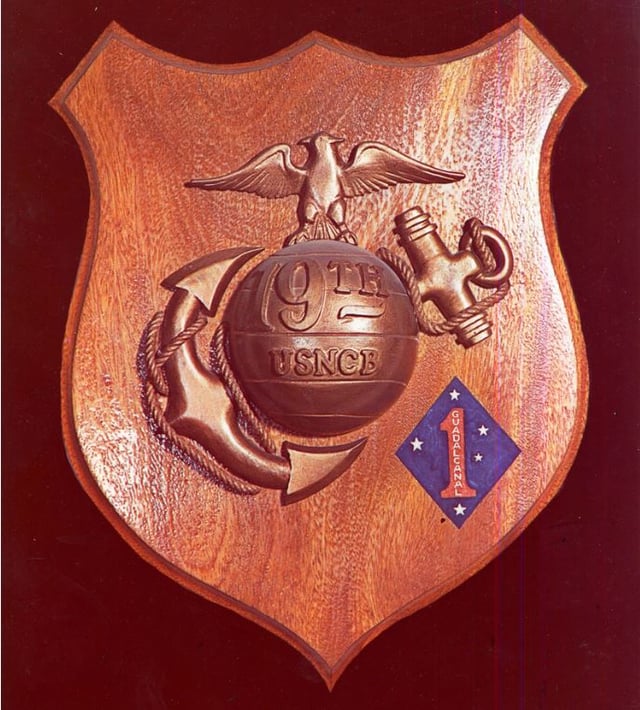
19th Naval Construction Battalion Plaque. The battalion was assigned to the 1st Marine Amphibious Corps and later redesignated 3rd Battalion 17th Marines, 1st Marine Division (Seabee Museum)).
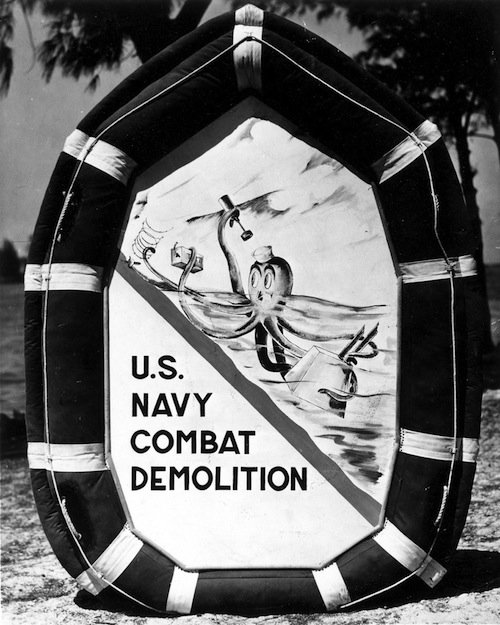
U.S. Naval Combat Demolition insignia (U.S. Navy Seal Museum)
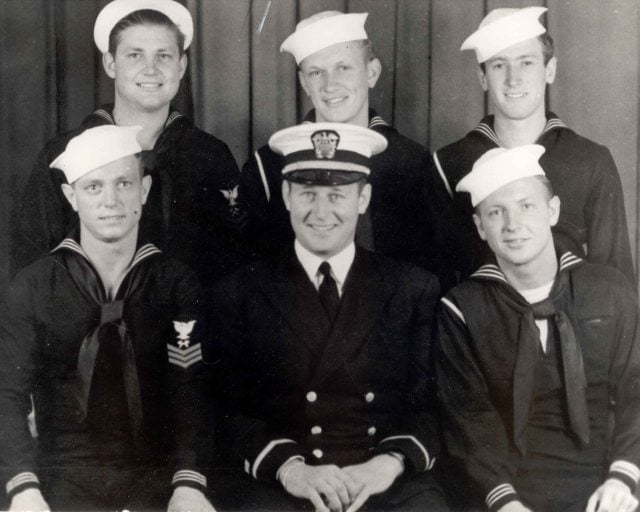
"NCDU 45", CEC Ensign Karnowski, Chief Carpenters Mate Conrad C. Millis, MM2 Equipment Operator Lester Meyers and three sailors. The unit received a Presidential Unit Citation with Ens. Karnowski earning the Navy Cross & French Croix de Guerre with Palm, while MM2 Meyers received a Silver Star.[76]
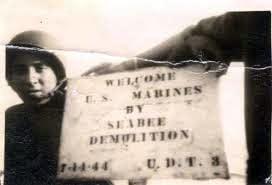
Seabees in both UDT 3 and 4 made signs to greet the Marines assaulting Guam. Lt. Crist confiscated this sign.[78] However, team 4 was able to leave theirs on the beach for the Marines to see that the Seabees had been there first. UDT 4 posted this sign again on the Hotel Marquee for its 25-year reunion.[88] (USN)

"17th Special" Seabees with the 7th Marines on Peleliu made national news in an official U.S. Navy press release.[107] NARA-532537
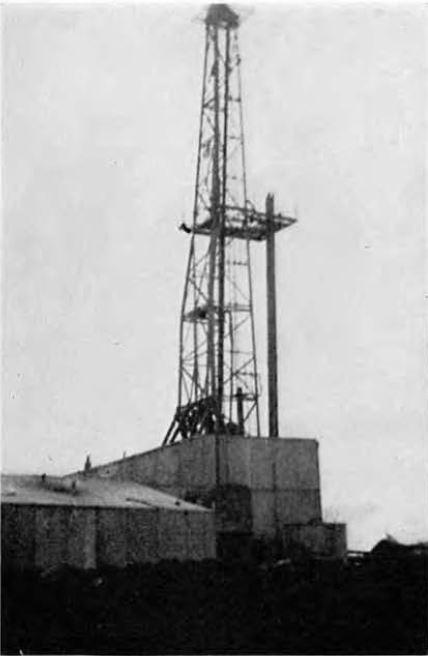
Winterized wildcat Seabee #1, in NPR 4, at Umiat, Alaska, (USN)
By summer of 1941 civilian contractors were working on large naval bases at Guam, Midway, Wake, Pearl Harbor, Iceland, Newfoundland, Bermuda, and many other places. BuDocks decided there was a need to improve the Navy's supervision of these projects through the creation of "Headquarters Construction Companies". The men in these companies would report to the officers in charge of construction and would be draftsmen and engineering aids needed for the administrative functions of the inspectors and supervisors overseeing the contracted work. These companies would consist of two officers and 99 enlisted men, but were not to do any actual construction. Rear Admiral Chester Nimitz, Chief of the Bureau of Navigation, authorized the formation of the 1st Headquarters Construction Company, on 31 October 1941. Recruitment started in November and as history would have it the company was formed on 7 December[9] with the men undergoing boot training at Naval Station Newport, Rhode Island. By 16 December 1941, four additional companies had been authorized, but 7 December happened, plans changed and with them the ratings needed by a change in mission. The 1st HQ Construction Company provided the nucleus for the formation of the 1st Naval Construction Detachment sent to Bora Bora in January 1942. Those men were part of Operation Bobcat[15] and are known in Seabee history as the "Bobcats". In December 1941, Rear Admiral Ben Moreell, Chief of BuDocks, recommended establishing Navy Construction Battalions and on the 28th requested authority to carry this out. On 5 January 1942, he got the go-ahead from the Navy's Bureau of Navigation to recruit construction tradesmen for three naval construction battalions. When Admiral Moreell submitted his request to form those battalions the other four HQ construction companies had been approved and authorized, so HQ Companies 2 & 3 were combined to form the 1st Naval Construction Battalion that were then were deployed as the 2nd & 3rd Construction Detachments. The 1st NCB was commissioned on 21 January at Charleston So. Carolina. The next HQ Companies 4 & 5 were combined to form the 2nd Naval Construction Battalion, and were deployed as the 4th and 5th Construction Detachments.[12] While those four HQ Companies provided the nucleus for two construction battalions they were all deployed in a manner similar to the first construction detachment and this sort of thing continued through the 5th NCB.[16] It was 6 NCB that was the first Battalion to deploy as a unit to the same place.[16]
Before all this could happen, a major problem still confronting BuDocks was who would command the Construction Battalions. Naval regulations stated that military command of naval personnel was strictly limited to line officers, yet BuDocks deemed it essential that these construction battalions be commanded by officers of the Civil Engineer Corps, who were trained in the skills required for construction work. The newly formed Bureau of Naval Personnel (BuPers), successor to the Navy's Bureau of Navigation, strongly opposed this proposal.[17] Admiral Moreell took the question personally to the Secretary of the Navy, Frank Knox, who, on 19 March 1942, gave authority for officers of the Civil Engineer Corps to exercise military authority over all officers and enlisted men assigned to construction units.[17] Two weeks prior on March 5, all construction battalion personnel were officially named Seabees by the Department of the Navy. Seabees have observed that date as their birth date since 1955;[18] before that, December 28 was the date the NCF observed.
The first men in the Seabees were not raw recruits trade wise, they were recruited for their experience and skills and were given advanced rank for it. As a group they were the highest paid the United States had in uniform during WWII.[19] To find the men with the necessary qualifications, physical standards were less rigid than other branches of the armed forces. The age range was 18–50, with the average of 37, during the first years of the war. Even so- they all were put through the same physical training.[6] These men had built the nation's dams, the national highway system, and skyscrapers. They had worked the mines, quarries and dug subways. They had built docks, wharfs and ships in the shipyards. After December 1942, President Franklin D. Roosevelt ordered that men for the construction battalions had to be obtained through the Selective Service System. By that time 60 CBs had been formed. However, men could enlist and then volunteer for the Seabees with a written statement that they were trade qualified.[1] [] This lasted until October 1943 when voluntary enlistment in the Seabees ceased until December 1944.[1] [] During this period the recruits were generally younger and had much less developed skill sets due to their age.[17] By the end of the war 258,872 officers and enlisted had served in the Seabees.[20] The NCTC's provided them training in more than 60 skilled trades. Almost 11,400 officers would join the Civil Engineer Corps during World War II with 7,960 of them having served with the Seabees.[17] The Seabees authorized number of 321,056 men was never reached.[20]
Recruits received three weeks of training initially at Camp Allen, Norfolk, Virginia in 1942. Camp Bradford at Little Creek, Virginia replaced Camp Allen which in turn was replaced by Camp Peary, Williamsburg, Virginia. Finally, all training was moved in 1944 to Camp Endicott at Quonset Point, Rhode Island. The first five battalions were sent directly overseas because of the urgent need of immediate construction of war dictated infra-structure. The newly formed battalions that followed, would be sent to one of the advance base depots and naval training centers (NTC) at Davisville, Rhode Island, Gulfport, Mississippi, or Port Hueneme, California. The Davisville advanced base depot became operational in June 1942, and on 11 August 1942 NTC Camp Endicott was commissioned. That Camp trained over 100,000 Seabees during World War II. Camp Thomas, a personnel-receiving station on the base, was established in October. Camp Rousseau at Port Hueneme became operational in May 1942. This base was responsible for staging about 175,000 Seabees directly to the efforts in the Pacific.[17] The other CB Camps were Camp Hollyday, Gulfport Mississippi, Camp Parks, Livermore, California, and Camp Lee-Stephenson, Quoddy Village, Eastport, Maine.
CBs sent to the Pacific were attached to one of the four Amphibious Corps: I, III, and V were U.S. Marine Corps (under Admiral Nimitz – Pearl Harbor, Territory of Hawaii) while VII was U.S. Army (under General MacArthur – Brisbane, Australia).
Advance bases The Navy wanted to enable open communications concerning advance base construction and development without being concerned the enemy had intercepted the transmissions[21] and the Office of Naval Operations created a solution.[22] These base construction operations were given a code name as a numbered metaphor for the size/type of base the Seabees were to construct and assigned to it the "unit" that would be the administration of that advanced base.[23][24] These were Lion, Cub, Oak and Acorn with a LION being a large Fleet Base numbered 1–6.[25] CUBs were Secondary Fleet Bases 1/4 the size of a Lion (numbered 1–12)[26]) OAK and ACORN were the names given airfield units of new or captured enemy fields (primary and secondary in size).[22][27] Cubs were quickly adopted as the primary type airfield with Oaks not being organized. The speed with which the Seabees were able to get a Cub operational caused the Navy to consider them a tactical component that was to be utilized as quickly as the Seabees could make it so. Camp Bedilion shared a common fence-line with Camp Rousseau at Port Hueneme. It was home to the Acorn Assembly and Training Detachment responsible for training and organizing Acorn units. Acorns were considered Seabee units.[28] CBs constructed, repaired or upgraded 111 major airfields with the number of acorn fields not published.[29] When the code was first created the Navy thought it would require two CBs to construct a Lion. By 1944 entire Construction Regiments were being used to build Lions. The projects and plans so grew and evolved that with the invasion of Okinawa the U.S. Navy had 4 Naval Construction Brigades of 55,000 Seabees on that island. This was not combat engineering. This was building the infra-structure required to take the war to Japan. Along the way, the Navy had realised that it also needed Advance Base Construction Depots (ABCDs) to get the job done. So the Seabees built them at 1. Nouméa, 2. Pearl Harbor, 3. Brisbane, 4. Milne Bay, 5. Samar, 6. Subic Bay, and 7. Okinawa.[30] (ACORN = acronym for Aviation Construction Ordnance Repair Navy: each had a CBMU attached)
By the end of 1945 the Seabees had constructed over 300 different advanced bases on as many islands.[31] More than 325,000 Seabees served on six continents and hundreds of islands during WWII. In the Pacific they built 111 major airstrips, 441 piers, PT boat & seaplane bases, bridges, roads, communication centers, tanks for the storage of 100,000,000 US gal (380,000,000 l; 83,000,000 imp gal) of fuel, hospitals for 700,000 patients, and barracks for 1.5 million men.[32][33]
Atlantic In the Atlantic CBs biggest job was the preparations for the assault on Europe and the Normandy landing. However, a long way from the beach 3 Seabee units took part in the crossing of the Rhine, CBMU 627, CBMU 628, and CBMU 629. For 629 it was front-line work.[34] The three CBMUs were formed from the 114th CB.
Marine Corps USMC historian Gordon L. Rottman wrote "that one of the biggest contributions the Navy made to the Marine Corps during WWII was the creation of the Seabees".[38] In turn, the Corps would be influential upon the CB organization and its history. In 1942 the marines issued USMC duffel bags and uniforms to Battalions 18-20.[39][40][41] In the records of both the 18th and 19th NCBs they each claim to have been the first CB authorized to wear the USMC uniform.[37] They both received their military training and USMC issue at Marine Training Center, New River, N.C. Marine Corps Base Camp Lejeune. How many other battalions received the USMC issue is not recorded but it is known that the 25th, 31st, 43rd,[42] 76th,[43] 121st and 133rd NCBs did also.[44] The Marine Corps listed CBs on their Table of organization: "D-Series Division" for 1942,[45] "E-Series Division" for 1943,[46][47] and "Amphibious Corps" for 1944/45.[48]
Starting with the 1st Naval Construction Detachment (a.k.a. Bobcats),[15] the Marines redesignated them the 3rd Battalion 22nd Marines.[49] They were the very first Seabees and that was only the beginning. They joined the 22nd Marines in September 1943 and were put through intensive combat training.[50] Right after them part of the 4th Naval Construction Detachment was assigned to the 5th Marine Defense Battalion on Funafuti for two years.[16] The Bureau of Yards and Docks original request of 28 December 1941 was for the authorization of three naval construction battalions.[9] [] When those three battalions were formed the seabees did not have a fully functional base of their own. So, upon leaving navy boot camp, those men were sent to National Youth Administration camps in Illinois, New Jersey, New York and Virginia to receive military training from the Marine Corps.[1] []
In 1942 the Marine Corps wanted a Seabee battalion for each division in the Pacific, but was told no because of war priorities.[9] [] However, by autumn 1942, things changed with NCBs 18, 19 and 25[51] being assigned to Marine Divisions as combat engineers.[52] Those battalions were posted to composite engineer regiments[53] and redesignated as the 3rd Battalion in their Regiment.[52] (See 16th Marine Regiment, 17th Marine Regiment,[54] 18th Marine Regiment,[55] 19th Marine Regiment, and 20th Marine Regiment.[44]) In August 1942, C company 18th NCB was transferred to the C.B. replacement group, fleet marine force, San Diego. The rest of the 18th embarked from the Fleet Marine Force Base Depot, Norfolk, VA, en route to Guadalcanal where they would replace the 6th NCB with the 1st Marine Division.[56] In the fall of 1943 two sections of the 6th Special NCB were sent to the Russell Islands with the 4th Marines Advance Depot.[16] In November, the 14th NCB landed with the 2nd Raider Battalion on Guadalcanal. Earlier in June the 24th NCB supported the landing of the 9th marine defense battalion on Rendova.[57] The 33rd CB had 202 men posted to the 1st Pioneers as shore party to the 5th Marines of the 1st Marine Division on Peleliu. Along with them were 241 from the 73rd CB.[58] Also attached to the 1st Pioneers was the entire 17th Special NCB (segregated). The 47th sent a detachment to Enogi Inlet on Munda attached to the 1st and 4th Marine Raiders.[49] On Bougainville Commander Brockenbrough of the 71st CB was named the shore party commander for the 3rd Marine Division with his battalion supported by elements of the 25th, 53rd, and the 75th CBs (and as well as the Marines).[59] The 75th had a 100-man detachment volunteer to land with a Company of 3rd Marines at Cape Torokina, Bougainville.[60] The 53rd also had detachments land as shore parties for the 2nd Raider Battalion on green beach and the 3rd Raider Battalion over on Puruata Island (Fig. 2).[61] The 121st was formed at NCB Training Center of the Marine Training Center – Camp Lejuene, New River, NC. There it was attached to the 4th Marine Division and assigned as the 3rd Battalion 20th Marines.[62]
In 1944 the Marine Engineer Regiments were inactivated. Even so, Marine Divisions still had a CB posted to them. For Iwo Jima, the 133rd and 31st NCBs were "attached" on temporary duty assignment (TAD) to the 4th and 5th Marine Divisions. For Okinawa it was the 58th, 71st, 130th, and 145th NCBs that were TAD to the 6th, 2nd, and 1st Marine Divisions. But, going back again to Iwo Jima, there the 31st and 133rd were not re-designated. The Marines were short of Marine "Pioneers" and the Seabees were "tasked" with the assignment. C Co 31st NCB was a component of the 5th Shore Party Regiment and was on the beach on D-day. The 31st NCB's demolitions echelon was under divisional control through D+10 with the 5th Marine Division.[63] The 133rd was posted to the 23rd Marines as their shore party.[64] The battalion had each company detached and tasked to the assault as follows: A Co – 1/23, B Co – 2/23, C Co – 3/23, and D Co – 2/25.[65] The overall command of the Iwo Jima shore parties was the 8th Marine Field Supply Depot. A chief and 25 heavy equipment operators from the 8th CB volunteered for a shore party detachment required by the 8th Depot for the D-day assault.[66]
With Iwo Jima secured the 5th Marine Division returned to Camp Tarawa where it was joined by the 116th NCB.[65] In August Japan fell and 116th NCB went with the 5th Marine Division as part of the occupation force. V-J day found thousands of Japanese troops still in China and the Third Marine Amphibious Corps was sent there to get them back to Japan. A portion of the 33rd Naval Construction Regiment was assigned to III Marine Amphibious Corps for this mission: i.e. the 83rd, 96th, 122nd CBs and the 33rd Special CB.[67][68]
Seabee Battalions were also tasked individually to the four Amphibious Corps. The 19th NCB was assigned to the I Marine Amphibious Corps (I MAC)[56] prior to being made an element of the 17th Marines. The 53rd NCB was posted to I MAC and designated the "Naval Construction Battalion 1st M.A.C.". Then, when I MAC was redesignated III Amphibious Corps the battalion became an element of the 1st Provisional Marine Brigade[60][69] until the brigade was deactivated 9 September 1944. For Guam, III Amphibious Corps had the 2nd Special NCB, 25th and 53rd NCBs. Lt. Cmdr. Whelan of the 25th CB was shore party commander for the 3rd Marine Regiment on beaches Red 1 and Red 2. V Amphibious Corps (VAC) had the 23rd Special and 62nd NCBs on Iwo Jima. Back on Tinian the 6th Naval Construction Brigade incorporated VAC's insignia as a part of the Brigade's indicating the entire brigade was attached to V Amphibious Corps.[70] The 6th Brigade was composed of: the 29th Rgt. with CBs; 18,[52] 50, 92, 107, & 135, the 30th Rgt. with CBs: 13, 67, 121,[52] & 123, and the 49th Rgt. with CBs: 9, 38, 110, & 112th (and the 27th Special).[71][72]
Two sections of CBMU 515 engaged in actual combat while attached to the 22nd Marines of the First Provisional Marine Brigade, III Amphibious Corps on Guam.[73]
With the war over the Seabees ended up with the most unique standing any U.S. military component has with the U.S. Marine Corps.[74] Seabee historian William Bradford Huie wrote "that the two have a camaraderie unknown else-wheres in the United States military".[75] It should be added that even though they are "Navy" the Seabees adopted USMC fatigues with a Seabee insignia in place of the EGA. During WWII a number of CBs adapted USMC insignia for their units, these included CBs 5, 18, 19, 25, 31, 53, 71, 117 and the 6th Brigade. The insignia each modified were the seahorse (5th Marine Rgt), Corps Castle (2nd Engineer Bn), the Eagle, Globe and Anchor, a divisional shield (3rd Marine Div.), a spearhead (5th Marine Div.), the eagle globe and anchor, a divisional shield (3rd Marine Div.), the USMC Bulldog, and an alligator with three stars (V Amphibious Corps).
see Notes: 2a–2l
Naval Combat Demolition Units: NCDUs
In early May 1943, a two-phase "Naval Demolition Project" was directed by the Chief of Naval Operations "to meet a present and urgent requirement". The first phase began at Amphibious Training Base (ATB) Solomons, Maryland with the establishment of Operational Naval Demolition Unit No. 1. Six Officers and eighteen enlisted men reported from NTC Camp Peary dynamiting and demolition school, for a four-week course on May 14.[77][76] Those Seabees, lead by Lieutenant Fred Wise CEC, were immediately sent to participate in the invasion of Sicily.[78][79]
Naval Combat Demolition Units (NCDUs) consisted of one junior CEC officer[80] and five enlisted and were numbered 1–216.[81] After that first group had been trained Lt. Commander Draper Kauffman was selected to command the program that had been set up in Camp Peary's "Area E" where the Seabee dynamiting and demolition school opened. Between May and mid-July six NCDU classes were the first men graduated from the school at Camp Peary before the program was moved to Fort Pierce. The first class at Fort Pierce began in mid-July.[82] Despite the move to Fort Pierce, Camp Peary remained Kauffman's manpower source. "He would go up to Camp Peary's dynamite school, assemble the (Seabees) in the auditorium and say, 'I need volunteers for hazardous, prolonged and distant duty."[6] Fort Pierce had two Seabee units assigned to the school, Construction Battalion Detachment (CBD) 1011 and Construction Battalion Maintenance Unit (CBMU) 570. Their jobs were the construction and maintenance of the various obstacles needed for the demolitions class to practice their training. The men in those classes referred to themselves as "Demolitioneers".[82]
The Navy had 34 NCDUs in England for the Invasion of Normandy. All told they suffered 53 percent casualties on Normandy.[6] While waiting for D-day the NCDUs trained with the 146th, 277th and 299th Combat Engineer Battalions.[83] Each NCDU had 5 men from a combat engineer battalion attached to the team. In the beginning the first 10 NCDUs were split into 3 groups.[83] The whole thing was a bit ad-hoc as they had no commanding officer, but the senior officer was the leader of group III, Lt Smith (CEC). He served in that capacity unofficially for the entire group.[83] His group III did a lot of experimental demolitions work and developed the Hagensen Pack.[83] As more teams arrived a NCDU Command was created for Normandy. Afterwards four NCDUs that were on Utah were joined by nine others for Operation Dragoon.
With Europe invaded Admiral Turner requisitioned all available NCDUs from Fort Pierce for integration into the UDTs for the Pacific. Thirty NCDUs[84] had been sent to the Pacific prior to Normandy while three had gone to the 8th Fleet in the Mediterranean. NCDUs 1–10 were staged at Turner City, Florida Island in the Solomons during January 1944.[85] NCDU 1 went briefly to the Aleutians in 1943.[86] NCDUs 4 and 5 were the first to see combat by helping the 4th Marines at Green island and Emirau Island.[86] A few were temporarily attached to UDTs.[85] Later NCDUs 1–10 were combined to form Underwater Demolition Team Able.[85] This team was disbanded with NCDUs 2 and 3 plus 19, 20, 21 and 24[87] being assigned to MacArthur's 7th Amphibious Force and were the only NCDUs remaining at the war's end. The other men from Team Able were assigned to numeric UDTs.
see Notes: 2m–2q
Underwater Demolition Teams: UDTs
Prior to Operation Galvanic and Tarawa, V Amphibious Corps had identified coral as an issue for future amphibious operations. Rear Admiral Kelly Turner, commander V Amphibious Corps had ordered a review to get a grip on the problem. VAC found that the only people having any applicable experience with the material were men in the Naval Construction Battalions. Lt. Thomas C. Crist of C Co CB 10 was sent back to Pearl Harbor from Canton Island[89] [90] where he had been involved in a lagoon coral head clearance project. His being in Pearl Harbor was pivotal in UDT history. While there he learned of the Admiral Turner's interest in coral blasting and made contact. The Admiral tasked Lt. Crist to develop a method for blasting coral under combat conditions and putting together a team to do it.[84] Lt. Crist started by getting men he had blasted coral with in CB 10. By the end of November 1943 he had close to 30 officers and 150 enlisted gathered at Waipio Amphibious Operating Base on Oahu.[84]
Earlier that month the Navy learned a hard lesson about underwater obstructions with coral and tides during the invasion of Tarawa. It prompted Admiral Turner to request the creation of nine Underwater Demolition Teams to deal with the problem.[91] Six would be assigned to VAC in the Central Pacific while the other three would go to III Amphibious Corps in the South Pacific. Admiral Turner chose the terms "under water" to distinguish from the Fort Pierce program. UDTs 1 & 2 were completely Seabees according to the UDT Archives[92] with Seabees making up the vast majority of the men in teams 1–9, 13 and 15.[93] How many Seabees were in UDT 10 is not cited in the records nor is anything stated for UDT 12. Seabees were roughly 20% of UDT 11.[93][94] UDT officers were mostly CEC.[95] At formation UDT 10 was assigned 5 officers and 24 enlisted, trained as OSS Operational Swimmers. The group was multi-service: Army, Coast Guard, Marine Corps and Navy (Maritime Unit: Operational Swimmer Group II).[96][97] but, the OSS was not allowed to operate in the Pacific Theater. Admiral Nimitz needed swimmers and did approve their transfer from the OSS to his operational and administrative control. The MU men brought with them the swimfins they had trained with and the Seabees made them a part of UDT attire as quickly as the Supply dept. could get them.[96] In the Seabee dominated teams the next largest group of UDT volunteers came from the joint Army-Navy Scouts and Raiders school that was also in Fort Pierce and the Navy's Bomb disposal School.
The first underwater demolition team commanders were Cmdr. E.D. Brewster (CEC) UDT 1 and Lt. Crist (CEC) UDT 2. (Lt. Crist was replaced because Admiral Conolly wanted Line Officers with combat experience) When Teams 1 and 2 were formed they were "provisional" with 180 men total.[98] The core of these teams came from the Seabees Lt. Crist had already gathered in Hawaii with seven different CBs represented in UDT 2.[93][84] They wore fatigues with life-vests and were not expected to leave their boats similar to the NCDUs. However, at Kwajalein Fort Pierce protocol was changed. Admiral Turner ordered daylight reconnaissance, and Ens. Lewis F. Luehrs and Seabee Chief Bill Acheson wore swim trunks under their fatigues. They stripped down, spent 45 minutes in the water in broad daylight. When they got out were taken directly to Admiral Turner's flagship, still in their trunks, to report. Admiral Turner concluded that daylight reconnaissance by individual swimmers was the way to get accurate information on coral and underwater obstacles for upcoming amphibious operations. This is what he reported to Admiral Nimitz.[99] At Engebi Cmdr. Brewster was wounded and all of the men with Ens. Luehrs wore swim trunks under their greens.[84] The success of those UDT 1 Seabees not following Fort Pierce protocol rewrote the UDT mission model and training regimen.[100] Ensign Luehrs and Chief Acheson were each awarded a Silver Star for their exploit[101] and they unintentionally created the UDT's "naked warriors" image. Diving masks were not common in 1944 and a few men had tried using goggles at Kwajalein.[102] They were a rare item in the Hawaiian sports stores so Lt Crist and Seebee Chief Howard Roeder and put in a request to supply for them.[102] A fortuitous observation spotted a diving mask ad in a magazine, which generated a priority dispatch to the States appropriating the store's entire stock.[102]
Three days after requesting the creation of UDTs Admiral Turner also requested the creation of a "Naval Combat Demolition Training & Experimental Base" at Kihei, Hawaii. The actions of UDT 1 were immediately incorporated in the training which made it distinctly different from that at Fort Pierce. The first head of training was Seabee Lt. Crist. He was in that position briefly from when UDTs 1 & 2 were decommissioned until he was made Commander of UDT 3. When UDT 3 returned from Leyte in November 1944 the team became the training instructors of the Oahu school and Lt. Crist was again Officer in charge of training.[93] Under Lt Crist the 2 month training course was broken into four 2 week blocks. With an overall emphasis on swimming and reconnaissance the teams also covered night ops, problems of control, small arms, bivouacking, small unit tactics, along with coral and lava blasting. The team would remain in these jobs until April 1945 when it was sent to Fort Priece to do the same job there. Lt Crist had been promoted to Lt. Cmdr and was sent back to Hawaii but his Team 3 Seabees would train teams 12-22.[93] Later the Seabees of UDTs 13 and 15 would be on the beach at Iwo Jima. They scouted prior to D-day, helped direct the first landing craft to the correct beaches on D-day and helped clear the beaches of debris on D-plus 2. UDT 14 is called the first "all fleet team" even though Seabees from Team Able were attached and the Commander and XO were both CEC (Ltjg A.B. Onderdonk and Ltjg C.E. Emery). UDT 15, formed completely of NCDUs made it a Seabee team too. After July 1944 new UDTs were completely USN with no Army or USMC. In 1945 CBMU 570 was tasked to support UDT coldwater training at ATB Oceanside, CA[103]
On Guam UDT 8 requested permission to build a base.[104] It was approved by Capt. Grayson AdComPhibsPac but disapproved by the Marine Island Commander.[104] While the Navy and Marine Corps commands were going back and forth Team 8 applied some devious means and the help of fellow Seabees in the battalions on Guam to appropriate everything needed to build their base.[104] The curshed coral paving only got done the night before Admiral of the Fleet, Chester W. Nimitz, Commander in Chief, U.S. Pacific Fleet did a base inspection of Teams 8 and 10. The Admiral gave the UDT base a glowing review.[104]
At wars end 34 teams had been formed with teams 1–21 having actually been deployed. The Seabees provided over half of the men in the teams that saw service. The U.S. Navy did not publicize the existence of the UDTs until post war and when they did they gave credit to Lt. Commander Kauffman and the Seabees.[105] During WWII the Navy did not have a rating for the UDTs nor did they have an insignia. Those men with the CB rating on their uniforms considered themselves Seabees that were doing underwater demolition. They did not call themselves "UDTs" or "Frogmen" but rather "Demolitioneers" which had carried over from the NCDUs[106] and LtCdr Kauffmans recruiting them from the Seabee dynamiting and demolition school. UDTs had to meet the military's standard age guidelines, Seabees older could not volunteer. In preparation for the invasion of Japan the UDTs created a cold water training center and mid-1945 UDT men had to meet a new physical standard. UDT 9 lost 70% of the team to this change.
see Notes: 2r–2u
African American Service: the Seabee stevedores
In February 1942 CNO Admiral Harold Rainsford Stark recommended African Americans for ratings in the construction trades. In April the Navy announced it would enlist African Americans in the Seabees. Even so, there were just two regular CBs that were "colored" units, the 34th[108] and 80th[109] NCBs. Both had white Southern officers and black enlisted. Both battalions experienced problems with that arrangement that led to the replacement of the officers.
The Navy had a huge need for cargo handlers.[110] The lack of stevedores for unloading ships in combat zones was creating a problem. On 18 September 1942 authorization was granted for the formation of a different type of CB denoted by the tag "Special" for cargo handling.[110] By wars end 41 Special Construction Battalions were commissioned of which 15 were "colored". Those Special CBs later became the first fully integrated units in the U.S. Navy.[111] The wars end also brought the decommissioning of every one of those units. The Navy's contemporary version of these units are Navy Cargo Handling Battalions of the Navy Expeditionary Logistics Support Group (United States).
Of particular note were the actions of the 17th Special at Peleliu 15–18 September 1944. On D-day the 7th Marines were in a situation where they did not have enough men to man the lines and get the wounded to safety. Coming to their aid were the 2 companies of the 16 Marine Field Depot (colored) and the 17th Special Seabee (colored). The Japanese mounted a counter-attack at 0200 hours on D-day night. By the time it was over nearly the entire 17th had volunteered to hump ammunition to the front lines on the stretchers they brought the wounded back on. They volunteered to man the line where the wounded had been, man 37mm that had lost their crews and volunteered for anything. The 17th remained with the 7th Marines until the right flank had been secured D-plus 3.[58][112][113][114][115][116] According to the Military History Encyclopedia on the Web, were it not for the "Black Marine shore party personal" the counterattack on the 7th Marines would not have been repulsed.[117]
On Peleliu, shore party detachments from the 33rd and 73rd CBs received Presidential Unit Citations as did the primary shore party (1st Marine Pioneers).[118] The Commander of the 17th Special CB (colored) received the same commendatory letter as the Company Commanders of the 7th Marine Ammo Co. (colored) and the 11th Marine Depot Co. (colored). Before the battle was even over, Major General Rupertus, USMC wrote to each: "The negro race can well be proud of the work preformed [by the 11th Marine Depot Company / 7th Marine Ammunition Company / 17th Special CB]. The wholehearted co-operation and untiring efforts which demonstrated in every respect that they appreciated the privilege of wearing a marine uniform and serving with the marines in combat. Please convey to your command these sentiments and inform them that in the eyes of the entire division they have earned a 'well done'."[119][120] The Department of the Navy made an official press release November 28, 1944 of the 17th CB's copy of this letter.[121]
Seabee North Slope Oil Exploration 1944
A Construction Battalion Detachment (CBD) was formed from "screening Camp Peary and the NCF for geologists, petroleum engineers, driller (oil), tool pushers, roustabouts and roughnecks" and later designated 1058.[124][125] Many of the enlisted and officers were chosen for their arctic experience with CB 12 and CB 66.[124] Once chosen the detachment was assembled at Camp Lee Stephenson. The original plan in 1944 had been to send them to the recaptured oil fields of New Guinea with the assignment to get those fields back in production.[125] This changed when Congress earmarked $1,000,000 for Operation Pet 4 and it was decided to send the unit to Alaska to determine if there was actually oil in NPR 4 (U.S. Navy Petroleum Reserve No. 4). NPR-4 had been created and placed in the oil reserve in 1923.[124] The area is known today as the National Petroleum Reserve in Alaska. The detachment's mission was to complete a detailed geologic study at Umiat and Cape Simpson, begin core hole and deep well drilling, as well complete aerial and overland pipeline surveys.[124] In 1944, a base camp was constructed a Point Barrow. Four D-8s with twenty sleds of supplies were readied for the 330 mile trek to Umiat once the ground froze to support them.[126] After those supplies were delivered the Cats returned to get the heavy well equipment.[126] During the summer of 1945 the Seabees drilled a 1,816-foot wildcat designated Seabee #1[127] before being shut down by the cold. The well site was near 4 known seeps at Umiat in the very south-east of NPR 4.[124][126] The rock in the area was from the Upper Cretaceous and a stratum of it was named the "Seabee Formation".[128] On the coast the Seabees drilled test holes at Cape Simpson and Point Barrow.[129] In March 1946 civilians took over for the Seabees some of whom had been members of CBD 1058 and were hired immediately upon discharge to continue in the same job they had performed for the Navy."[128] The Navy drew upon the cold weather experience it gained from CBD 1058 and applied it in Operation Highjump and Operation Deep Freeze. – Today Seabee #1 is a USGS monitor well.[130]
Land surveys
Twice the Seabees have been tasked with large scale land surveys. The first was done by CBD 1058 for a proposed NPR 4 pipeline route to Fairbanks. They also had a group of USN geologists assigned to map the Reserve's geology. In doing this work they would discover the large Aupuk Gas Seep near the Aupuk Creek fork with the Colville River.[131][132] The second would be done by a Seabee team from MCB 10. That group was sent to Vietnam in 1956 to survey and map that country's entire road network.[133] This work would be heavily drawn upon during the Vietnam conflict.
see Notes: 2a–2wa
WWII Cold War interlude – Siberia, China
When the Japanese signed the surrendered CB 114 was in the Aleutians. In September 1945 the battalion was ordered to send a detachment to the USSR to build a Naval Advance Base (a Fleet Weather Central).[134][135] It was located 10 miles (16 km) outside Petropavlovsk-Kamchatsky on the Kamchatka Peninsula and code named TAMA.[136] The original agreement gave the Seabees 3 weeks to complete the camp. Upon arrival the Russians told the Seabees they had 10 days and were amazed that the Seabees did it.[136] It was one of two that Stalin agreed to. The other was near Khabarousk, Siberia in buildings provided by the Russians.[136] For mail Petropavlovsk was assigned Navy number 1169, FPO San Francisco.[137]
With the fall of Japan Operation Beleaguer was initiated for the repatriation of thousands of displaced citizens in China as well as getting the remnants of the Japanese Army home. Part of the 33rd CB Regiment was involved; CBs 83, 96, 122 and 32nd Special.[138] These units landed at Tsingtao and Tangku in November 1945 attached to the 6th Marine Division. CB 42 and A Co. 33rd Special landed at Shanghai TAD to Naval Advance Base Unit 13.[139] With the war over, the discharge of all men eligible for discharge left only enough men for one CB and the two Specials. The men were consolidated in the 96th[138] and the other units were decommissioned. In December the 96th started construction of airfields at Tsingtao and Chinwangtao to support III Marine Amphibious Corps operations.[138] On 20 May 1946 orders were issued for CB III Marine Amphibious Corps to inactivate 96 CB on 1 August. Before that happened the 6th Marine Division was renamed the 3rd Marine Brigade which existed only until 10 June. At that time the 96th CB was transferred to the 4th Marines of the 1st Marine Division and were deactivated from them in August. An unknown CBMU was supposed to take over the maintenance of the airfields,[138] but Operation Beleaguer was close to completing its mission.
Cold War: Operation Crossroads
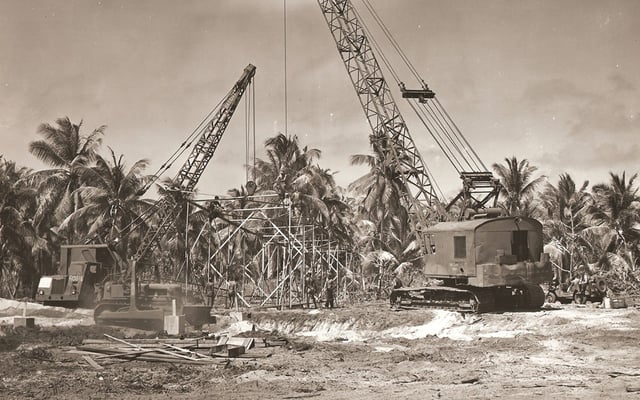
The 53rd CB erecting camera towers on Bikini Atoll for filming the tests. (Seabee Museum)
In early 1946 the 53rd NCB was still attached to III Marine Amphibious Corps[140] and was deployed for the preparations of the nuclear testing at Bikini Atoll as a component of Operation Crossroads.[141] At Bikini the battalion was assigned to Task Group 1.8 and designated TU 1.8.6.[142] The project list included observation and communication towers, general base facilities, and dredging the lagoon. On 3 August the battalion was decommissioned with the men transferred to CBD 1156 that was commissioned on Bikini.[143] The TU 1.8.6 designation continued with them. The Battalion remained on the atoll for nine days after the second nuclear test when it was detached from the Marine Corps and deactivated there.[140][144]
UDT 3 was designated TU 1.1.3 for the operation. On 27 April 1946, 7 officers and 51 enlisted embarked the USS Begor (APD-127) at the Seabee's base, Port Hueneme, for transit to Bikini.[145] Afterwards in 1948 the displaced natives put in a request to the U.S. Navy to blast a channel for access to the island Kili they had been relocated on. This was given to the Seabee detachment on Kwajelin who placed a request for UDT 3. The King of the Bikinians was so pleased he held a going-away feast for the UDTs.
In January 1947, CBs 104 and 105 were reactivated to join CB 103. The 121st CB was inactivated 31 December 1947 and re-designated CBD 1504.[146] CBMU 650 was at Attu in 1947. The Seabees were officially organized in the Naval Reserve during that month also. The 30th NCR was home-ported on Guam commanding 16 Construction Battalion Detachmnents and NCB 103. In 1949, when the 103rd was made a Mobile Construction Battalion CBs 104 and 105 were made Amphibious Construction Battalions. Between 1949 and 1968 CBs were organized into these two types of battalions MCBs or ACBs. In June 1950 the Naval Construction Force numbered approximately 2,800 active duty.[147] Most of the 30th's CBDS were formed in 1947 and all were decommissioned by January 1953.[148] They were the last NCF units whose mission was base Public Works.
CBD 1501 Johnson Island[148]
CBD 1502 NAS Orote, Guam[148]
CBD 1503 Truk & Midway Island[148]
CBD 1504 Peliliu & Is. Public Works, Saipan[148]
CBD 1505 Philippines & Midway Island[148]
CBD 1506 Samoa & NAS Agana, Guam[148]
CBD 1507 Wake Island & NOB Guam[148]
CBD 1508 NOB Subic, Philippines[148]
CBD 1509 Kwajalein[148]
CBD 1510 NAS Tanapag, Saipan[148]
CBD 1511 NAF Naha, Okinawa & Philippines[148]
CBD 1512 NAS Kobler, Saipan[148]
CBD 1513 NAS Sangley, Philippines[148]
CBD 1525 Okinawa[148]
CBD 1802 Okinawa[148]
CBD 1803 Island Public Works, Guam[148]
Cold War: Korea
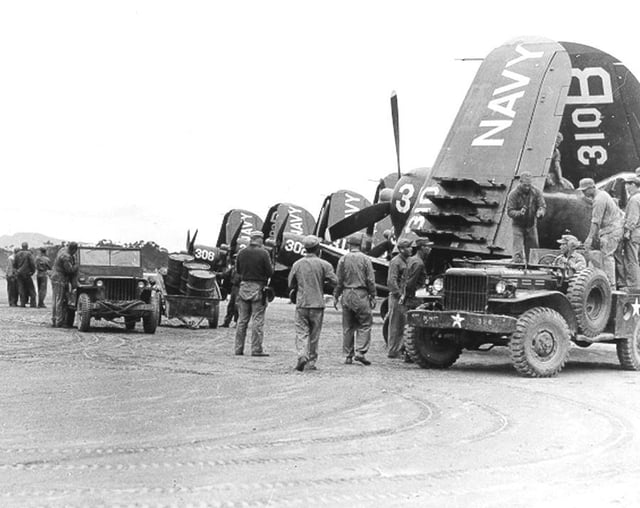
Yo Do Island airfield constructed by ACB 1 behind enemy lines. During the year it was used it was credited with saving 60 aviators. Seabees in photo refueling Corsairs on 15 July 1952. [149] [150] (USN)
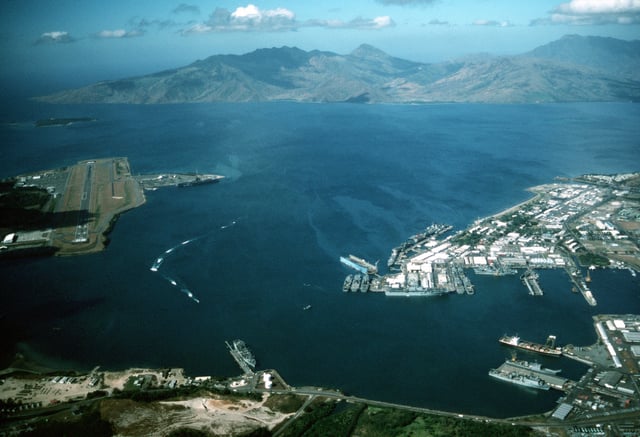
Naval Air Station Cubi Point left, U.S. Naval Base Subic Bay right. Seabees leveled a mountain that civilian contractors said could not be done. (USN)
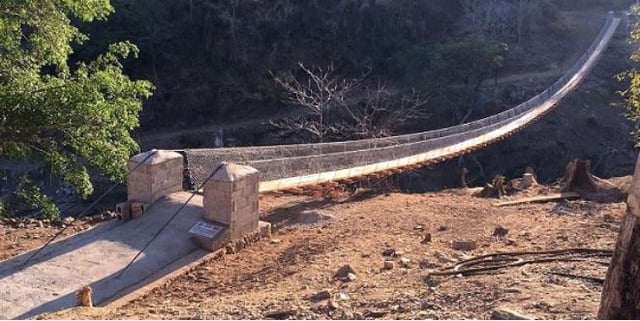
Suspension bridge built by NMCB 5 CCAD in Timor-Liste 2015 (Seabee Museum)
The outbreak of the Korean War in June 1950 led to a call-up of more than 10,000 men from the Seabee Naval Reserve program. The Seabees landed at Inchon with the assault troops. They dealt with enormous tides and enemy fire while installing causeways within hours of the initial landings. Their action here and at other landings emphasized the role of the Seabees. During the conflict the authorized size of a CB was 550 men.[150] When the truce was declared there was no Seabee demobilization as there had been at the end of WWII.
During the Korean War, the Navy realized they needed a naval air station in this region. Cubi Point in the Philippines was selected, and civilian contractors were initially selected for the project. After seeing the forbidding Zambales Mountains and the maze of jungle, they claimed it could not be done. The Navy then turned to the Seabees. The first Seabees to arrive were CBD 1802 to do the surveying. MCB 3 arrived on 2 October 1951 to get the project going and was joined by MCB 5 in November. Over the next five years, MCBs 2, 7, 9, 11 and CBD 1803 all contributed to the effort. They leveled a mountain to make way for a nearly 2-mile long (3.2 km) runway. NAS Cubi Point turned out to be one of the largest earth-moving projects in the world, equivalent to the construction of the Panama Canal. Seabees there moved 20 million cubic yards (15 million cubic metres) of dry fill plus another 15 million that was hydraulic fill. The $100 million facility was commissioned on 25 July 1956, and comprised an air station and an adjacent pier that was capable of docking the Navy's largest carriers. Adjusted-for-inflation, today's price-tag for what the Seabees built at Cubi Point would be $906,871,323.53. (that excludes the rest of the Naval Base at Subic Bay).
During the Korean War the Service School Command U.S.N.T.C. Great Lakes, Illinois, was the location of the U.S. Naval School Construction Battalion Reserve.[151]
The first Seabees to be referred to as Seabee Teams were CBD 1802 and CBD 1803.[154] Someone in the U.S. State Department learned of these men and adopted the idea as a way for making "good use" of the Seabees in the Cold War. They could be sent as "U.S. Good Will Ambassadors" to third world nations as a means to combat the spread of Communism and promote "Good Will", a military version of the Peace Corps. These 13 man teams would construct schools, drill wells or build clinics creating a positive image or rapport for the U.S. in the developing world. They were utilized by the United States Agency for International Development and were in S.E. Asia by the mid 1950s. Then in the early sixties the U.S. Army Special Forces were being sent into rural areas of South Vietnam to develop a self-defense force to counter the Communist threat and making use of the Seabee teams at these same places made perfect sense[155] to the CIA. So twelve "Seabee teams with Secret Clearances were sent to Vietnam to assist the U.S. Army's Special Forces in the CIA funded Civilian Irregular Defense Group program (CIDG)"[156][157] in the years 1963–1965. By 1965 the U.S. Army had enough engineers in theater to end the Seabees involvement with the Special Forces. At first they were called Seabee Technical Assistance Teams or STAT and were limited to two teams in the country at a time. Teams after STAT 1104 were renamed Seabee Teams and by 1969 there were 17 teams in the country concurrently. In total 128 teams were sent to Vietnam[157] with STAT 1104 being the most decorated group of Seabees ever. As a group the Seabee Teams received many awards for heroism.[158] While Vietnam went on the teams were still being sent to other nations. The Royal Thai government requested STATs in 1963 and since then nearly every time a CB has left the United States for a deployment a Seabee team has been sent somewhere.
Construction Civic Action Details or CCAD[152] CCADs or "See-Kads" are larger civic action units of 20–25 Seabees[159] with the same purpose as Seabee Teams. The CCAD designation is not found in the record prior to 2013 and there is no explanation stating why these construction crews are called "details" and not "detachments".
Cold War: Antarctica
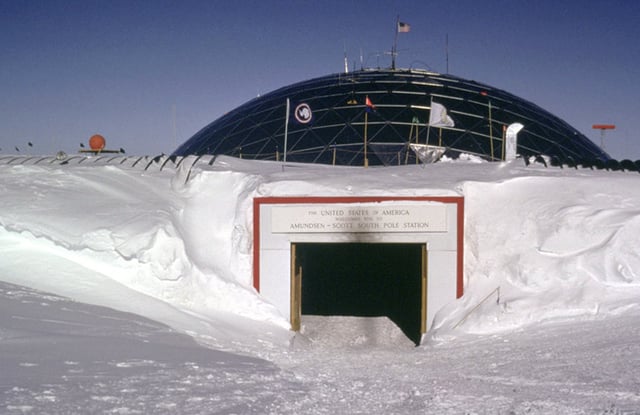
Amundsen-Scott South Pole Station, constructed by NMCB 71 (USN)
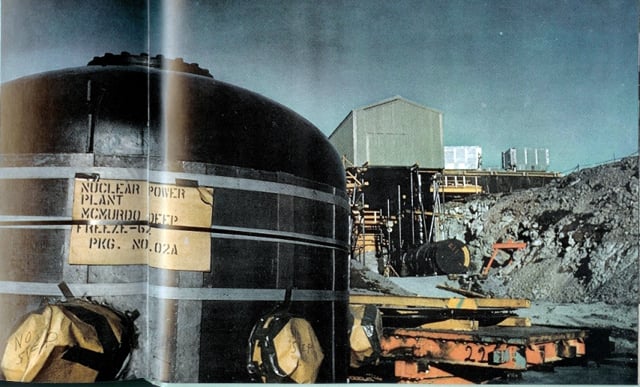
Tank for PM3a nuclear reactor built by MCB 1 at McMurdo Station (U.S. Navy)

MCB 1 Sled train departing Little America for traverse to Byrd Station (646 miles) or the South Pole (850 miles). The Navy special ordered SD-LGP D8s (SD=stretched dozer, LGP=low ground pressure)[162] with the frames extended 4 feet and tracks 54 inches wide[162] resulting in a ground pressure of 4.30 psi and blades 18.5 feet wide. There were two types of sleds: 10 ton or 20 ton that could be hitched in multiples. (U.S. Navy).
Operation Highjump
On 2 and 5 December 1946, 166 Seabees sailed from Port Hueneme on the USS Yancey and USS Merrick assigned to Operation Highjump. They were part of Admiral Richard E. Byrd's Antarctic expedition. The U.S. Navy was in charge with "Classified" orders "to do all it could to establish a basis for a (U.S.) land claim in Antarctica".[160] The Navy sent the Seabees to do the job starting with the construction of Little America (exploration base) IV as well as a runway for aerial mapping flights.[161] This Operation was vastly larger than IGY Operation Deep Freeze that followed.[160]
Operation Deep Freeze
In 1955, Seabees began deploying yearly to the continent of Antarctica as participants in Operation Deep Freeze. Their mission was to build and expand scientific bases located on the frozen continent and further establish a land claim for the U.S. (Fig. 19). The first "wintering over" party included 200 Seabees who distinguished themselves by constructing a 6,000-foot (1,800 m) ice runway on McMurdo Sound. Despite a blizzard that undid the entire project, the airstrip was completed in time for the advance party of Deep Freeze II to become the first to fly into the South Pole by plane. MCB 1 was assigned for Deep Freeze II.
Despite the adverse conditions, Seabees added to their list of accomplishments such things as snow-compacted roads, underground storage, laboratories, and living areas. One of the most notable achievements was MCB 1s construction of Antarctica's first nuclear power plant in 1962,[163] which got them a Navy Unit Commendation. Another, in 1975, was the construction of the Buckminster Fuller Geodesic dome at Amundsen-Scott South Pole Station by NMCB 71.[164] with a diameter of 164 ft (50 m) and 52 ft (16 m) high. This became a symbolic icon of the United States Antarctic Program until it was replaced.
Cold War: CIA and Naval Intelligence/Communication support
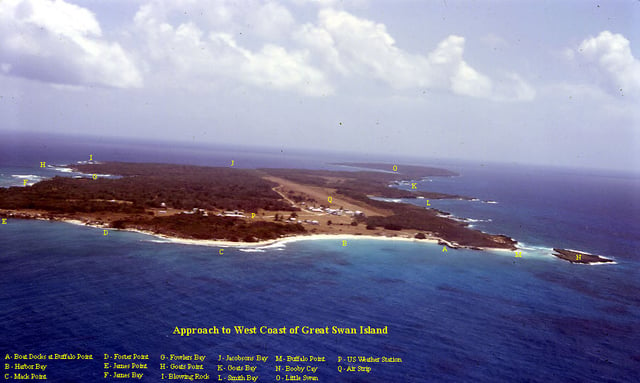
CIA runway by MCB 6 Det Alfa on Swan Island
CIA
After the Seabees left Camp Peary the CIA moved into the base and now refer to the it as "the Farm".
During WWII NAS Tanapag, Saipan was a "giant forward propaganda base for the U.S. Navy and the Office of War Information" (OWI).[165] In 1947 Construction Battalion Detachment 1510 began maintaining NAS Tanapag for the NTTU (Naval Technical Training Unit).[166][167] In 1948 CBD 1510's 256 men were transferred to CBD 1504 about the same time 1504 relieved CB 121 as island Public Works. In addition to the base and two airfields there were four radio transmission towers to maintain. That year the CIA began using the NTTU as a cover for its Saipan operation and made access highly restricted to NAS Tanapag. Station Security was instructed any unauthorized intrusions were to be shot with no questions asked.[168] The Organization had Capitol Hill constructed to administer its operations at a cost of $28 million. There is no record of who did the construction. The station covered the entire Northern half of Saipan including both Kagman Field and Marpi Point Field.[167] "Brig. Gen. Edward G. Lansdale, Pentagon expert on guerrilla warfare, shared with Gen. Maxwell D. Taylor, President Kennedy's military adviser, on "Resources for Unconventional Warfare in SE. Asia."....that the "CIA maintains a field training station on the island of Saipan ... the installation is under Navy cover and is known as the Naval Technical Training Unit. The primary mission of the Saipan Training Station is to provide physical facilities and competent instructor personnel to fulfill a variety of training requirements including intelligence tradecraft, communications, counter-intelligence and psychological warfare techniques. Training is performed in support of CIA activities conducted throughout the Far East area."[169] There is a date of 1953 for when the Seabees ceased the Public Works assignments at NAS Tanapag and Saipan while the CIA remained until 1962. However, MCB 9 deployed to Saipan in 1954 with one of their projects being the up-grading of the Public Works shops.[170] MCB 10 Det Bravo deployed to Saipan from July 1957 until February 1958 with projects unlisted.[171]
A year before the Bay of pigs and Cuban Missile Crisis the CIA took an urgent/immediate project to the Seabees.[172] The agency wanted two 220' radio towers with a supporting airstrip, dock, and quonsets erected on Swan Island, built asap, with no construction plans for the Seabees.[172] The station would be independent and self powered. Det Tango of MCB 6 was given the project.[172] LSTs 1046 and 1056 were loaded at Quonset Point with all the men and materials required.[172] The Seabees had the CIA's "Radio Swan" on the air in short order.[172]
The CIA had a station at the Subic Bay Naval Base. There is no record of who did that construction of the 100 housing units, two story office building and large warehouse.[173][174]
CIA redacted memorandum dated 14 June 1968 discusses the use on Naval Construction Personal/Seabees on a project that appears to be CONUS. As is, the GSA is forbidden from using "Naval Personnel" however, the memorandum discusses the possibility for releasing the project in two parts: non-sensitive areas and security sensitive areas. This approach would allow the GSA a means around the restriction of using Seabees in CONUS by arguing they were necessary for "National Security".[175]
Naval Intelligence: NAVFACs
For the Navy, public works Seabees maintained the Naval Facilities (NAVFACs) tracking Soviet submarines. The Navy built 22 NAVFACs for its Sound Surveillance System (SOSUS). They were in service 1954-79. In the 80s technology reduced the number of tracking stations to 11 with advent of the Integrated Underwater Surveillance System (IUSS). The Seabees still provided the base Publics Works for each NAVFAC. The NAVFAC tracking facilities were finally undone by further advances in tech, the end of the Cold War and disclosures by John Walker to the Soviets.
The Seabees have also been tasked building Naval Communication facilities. An example is the one at Nea Makri Greece built by MCB 6 in 1962 and upgraded by NMCB133. Naval Communications Station Sidi Yahya is another going back to WWII and CB 120. Still another that has had on-going Seabee support is NavCommSta Guam. It started out on the island as the Joint Communications Agency (JCA) in 1945. The Communications base was a project of the 5th Naval Construction Brigade.
see Notes: 7a-7b
Cold War: Vietnam
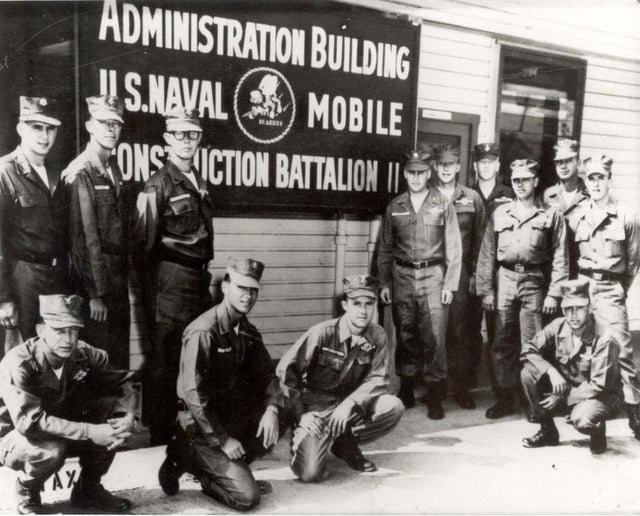
STAT 1104 in Port Hueneme L-R standing: John Klepher, Dale Brakken, William Hoover KIA, Ltjg Peterlin, Cmdr L.W.Eyman, Douglas Mattick, James Keenan, J.R. McCully, Marvin Shields KIA, kneeling: Richard Supczak, F.J. Alexander Jr, James Wilson, Jack Allen. For their actions in the Battle of Dong Xoai, the 9-man team received the Navy Unit Commendation a Medal of Honor, 2 Silver Stars, 6 Bronze Stars with Vs and 9 purple hearts. (USN)
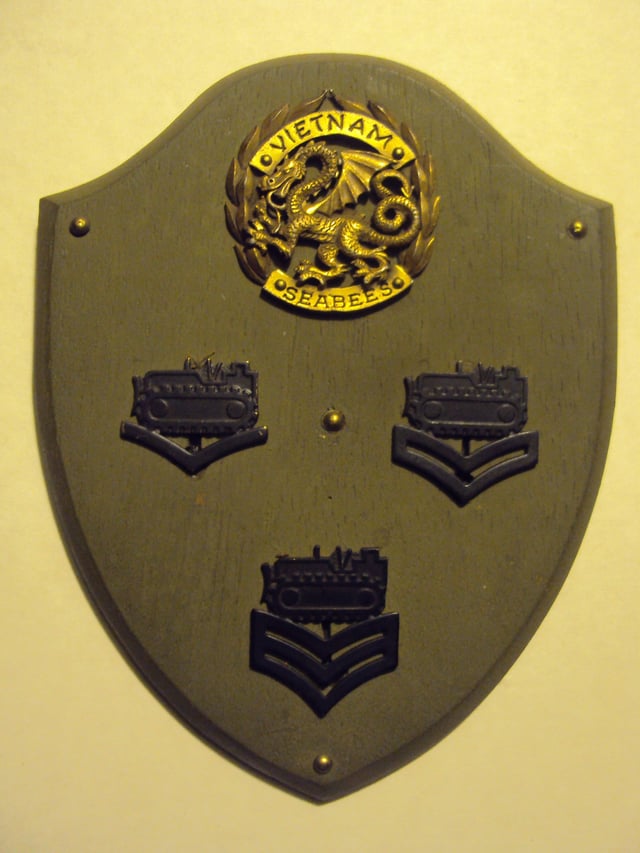
Vietnam era EO3 – EO1 collar devices
Seabees deployed to Vietnam twice in the 1950s. First in June 1954 as elements of Operation Passage to Freedom and then two years later to map and survey the nation's roads. Seabee teams 501 and 502 arrived on 25 January 1963 and are regarded as the first Seabees of the Vietnam War. They were sent to Dam Pau and Tri Ton to build camps for the Special Forces.[176]In 1964 ACB 1 was the first CB in the theatre. Beginning in 1965 Naval Construction Regiments (NCRs) deployed throughout Vietnam. The Seabees supported the Marines at Khe Sanh and Chu Lai combat base in addition to building a staggering number of aircraft-support facilities, roads, and bridges. Seabees also worked with and taught construction skills to the Vietnamese people. "In 1966, Navy Seabees rebuilt the damaged airfield at Khe Sahn in four days, with 3,900 feet of 60-foot-wide aluminum matting to serve cargo planes. General Westmoreland 'called it one of the most outstanding military engineering feats in Vietnam.'"[177] Lt. Joseph J. Rhodes of MCB 121 was the first CEC KIA (23 October 1967).[178] In June 1965, Construction Mechanic 3rd Class Marvin G. Shields was a member of Seabee Technical Assistance Team 1104, which took part in the Battle of Dong Xoai. He was posthumously awarded the Medal of Honor for his actions there and is the only Seabee ever to be awarded the Medal of Honor. Those Seabee "Civic Action Teams" continued throughout the Vietnam War and often were fending off enemy forces alongside their Marine and Army counterparts. Teams typically built schools, clinics, or drilled wells. MCB 4 had a detail at Con Thien whose actions on 8 May 1967 received a letter of Appreciation from the Commander Special Forces Det A-110 plus 5 endorsements.[179] The well det OIC and 11 men were wounded in the attack.
In 1968 the Marine Corps requested that the Navy make a name change to the CBs. The Marines were using "MCB" for Marine Corps Base and the Navy was using "MCB" for Mobile Construction Battalions. The Navy then added "Naval" to MCB creating the NMCBs that now exist. In May 1968 two reserve battalions were activated (RNMCBs 12 and 22), which brought the total number of battalions rotating to Vietnam to 21 (not including ACBs 1 and 2 or the two Construction Battalion Maintenance Units (CBMUs) that were there too). Also in 1968 there was an unusual "tasking" for NMCB 10. Their entire deployment was in support of the 101st Airborne in I Corps. During 1969 the total number of Seabees that had deployed topped out at 29,000 and then their draw-down began.[180] The last battalion withdrew at the end of 1971, which left three Seabee teams. They were out by the end of 1972. When it was over they had sent 137 Seabee teams, built 15 of their own Seabee Camps, and deployed 22 Battalions.[181] Of those 15 camps, one was labeled a CBC. During the conflict CBMU 302 became the largest battalion in Seabee history with over 1400 men and was homeported in theater at Cam Rahn Bay. On 23 April 1975, President Ford announced that U.S. involvement in Vietnam was over. On that date NMCB 4 started construction of a temporary camp for Operation New Life refugees on Guam at the WWII location of the Japanese airfield on the Orote peninsula. The battalion was ordered to erect 2000 squad tents in seven days, each measuring 16 x 32 feet. By the time they were done, NMCB 4 had built 3546 tents.[182]
During the Vietnam War there were uniform variations. Across the back of the field jacket M-65, the unit number was stenciled between the shoulders (e.g., "MCB 1").[183] Another variation was the collar and cover devices for E4 – E6 enlisted personnel. The Navy authorized that the "crow" for the construction group be replaced by the rating insignia for each trade. These devices were made in gold and black (subdued). Nametags on the fatigues were white with a multicolored seabee until 1968 The NAVCATs of CBMU 302 were authorized to wear a shoulder patch indicating each team's number.[184]
NAVCATs Naval Construction Action Teams
Agent Orange
Many Seabees were exposed to the defoliant herbicide while in Vietnam. NCBC Gulfport, Mississippi was the largest storage depot in the United States for agent orange. From there it would be transported by ship to Southeast Asia.[187] In 1968 the Seabee base received 68,000 55 gal. barrels to ship.[188] Long term storage of barrels began in 1969 that lasted until 1977. It was 30 acres in size and was still being cleaned up in 2013.[187][189]
(See notes 8a–8d)
Camp David
Camp David is officially known as Naval Support Facility Thurmont, because it is technically a military installation. The staffing is primarily provided by the CEC, Seabees,[190] and Marines of the U.S. Navy and Marine Corps. "In the early 1950's, the first Seabee BUs, UTs and CEs took over routine maintenance and repairs of the base. Although there have been vast changes made at the Camp over the years, Seabees continue to staff base public works while keeping the grounds in an impeccable condition."[191] Additional Naval rates were added to oversee base administrative functions. "Selectees undergo a single scope background investigation to determine if they are eligible for a Top Secret Sensitive Compartmentalized Information (TS/SCI) Yankee White (YW) clearance. All personnel assigned to duty in Presidential support activities are required to have a "Yankee White" clearance. The tour lasts 36 months."[190] When the base has a larger construction project a regular Naval Construction Battalion will send a detachment to take care of the job. CBs 5 and 133 have drawn these assignments.
Cold War: Naval Support Unit: Department of State
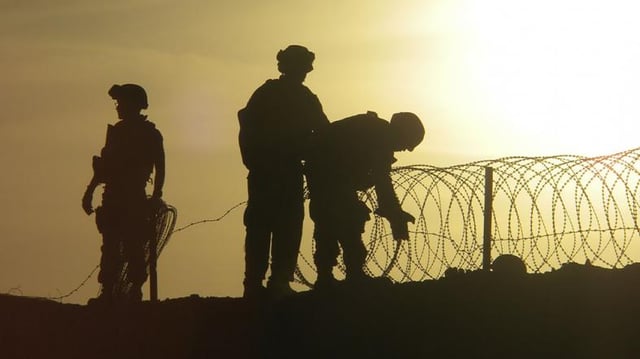
Naval Support Unit Seabees securing a diplomatic compound in Dec. 2010. (Dept. of State)[192]
Seabees were first assigned to the State Department in 1964 because listening devices were found in the Embassy of the United States in Moscow.[193] Initially the Seabees were members of "Naval Mobile Construction Battalion FOUR, Detachment NOVEMBER",[194] The U.S. had just constructed a new embassy in Warsaw so the Seabees were dispatched and found lots of "bugs". This led to the creation of the support unit in 1966 and made permanent in 1968.[195] That year William Darrah, a Seabee of the support unit, is credited with saving the U.S. Embassy in Prague, Czechoslovakia from a potentially disastrous fire.[196] In 1986, "as a result of reciprocal expulsions ordered by Washington and Moscow" Seabees were sent to "Moscow and Leningrad to help keep the embassy and the consulate functioning".[197]
The Support Unit has a limited number of special billets for select NCOs, E-5 and above. These Seabees are assigned to the Department of State and attached to Diplomatic Security.[198][193] Those chosen can be assigned to the Regional Security Officer of a specific embassy or be part of a team traveling from one embassy to the next. Duties include the installation of alarm systems, CCTV cameras, electromagnetic locks, safes, vehicle barriers, and securing compounds. They can also assist with the security engineering in sweeping embassies (electronic counter-intelligence). They are tasked with new construction or renovations in security sensitive areas and supervise private contractors in non-sensitive areas.[199] Due to Diplomatic protocol the Support Unit is required to wear civilian clothes most of the time they are on duty and receive a supplemental clothing allowance for this. The information regarding this assignment is very scant, but State Department records in 1985 indicate Department security had 800 employees, plus 1,200 Marines and 115 Seabees.[200] That Seabee number is roughly the same today.[201]
see Notes: 9a-9c and 5a
Cold War: NASA, Tektite I
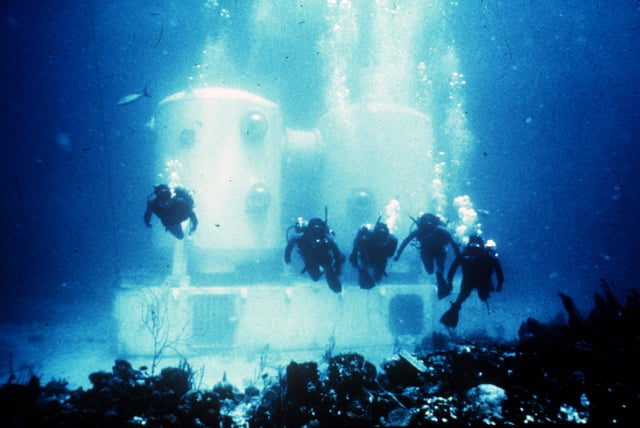
Tektite I assembled by ACB 2 (NOAA)
In 1960 MCB 103 built a Project Mercury telemetry and ground instrumentation station on Canton island.[202]
On 28 January 1969 a detachment of 50 men[203] from Amphibious Construction Battalion 2 augmented by an additional 17 Seabee divers from both the Atlantic and Pacific fleets as well as the 21st NCR began the installation of the Tektite habitat in Great Lameshur Bay at Lameshur, U.S. Virgin Islands.[204] The Tektite program was funded by NASA and was the first scientists-in-the-sea program sponsored by the U.S. government.[205] The Seabees also constructed a 12-hut base camp at Viers that is used today as the Virgin Islands Environmental Resource Station.[206] The Tektite project was a product of the Cold War and caused the U.S. Navy to realize it needed a permanent Underwater Construction capability. "It was this project that led to the formation the Seabee Underwater Construction Teams".[207]
see Notes: 10a-10c
Cold War winds down
As the Cold War wound down, new challenges were presented by the increased incidence of terrorism. This was in addition to numerous ongoing support missions like the Guam[208] and Okinawa[208] as well as the Navy and Marine Corps had Bases in Japan, Philippines,[208] Puerto Rico,[208] Cuba and Guatemala[208] that still required Seabee support. Even though the Cold war had wound down Cold War Facilities still required the Seabees for Polaris and Poseidon submarines at Holy Loch, Scotland, Rota, Spain, Naples, Italy, and Souda Bay, Crete.[208] In 1971, the Seabees began their second huge peacetime construction Diego Garcia[208] on a small atoll in the Indian Ocean. This project began in 1971 and was completed in 1987 at a cost of $200 million. Because of the extended time-frame, it is difficult to inflation-adjust that cost into today's dollars. The complex accommodates the Navy's largest ships and cargo planes. This base proved invaluable when Iraq invaded Kuwait in August 1990 and Operations Desert Shield and Desert Storm were launched.
CN Carmella Jones became the first female Seabee when she cross-rated to Equipment Operator during the summer of 1972.[209]
Seabee construction efforts led to the expansion and improvement of Naval Air Facility, Sigonella, Sicily, turning this into a major base for the United States Sixth Fleet aviation activities.
There were combat roles as well. In 1983, a truck bomb demolished the barracks the Marines had secured in Beirut, Lebanon.[208] After moving to the Beirut International Airport and setting up quarters there, Druse militia artillery began harassing the Marines. After consultations with the theater commander, Marine amphibious command and combat engineers, the forward-deployed battalion, NMCB-1 in Rota, Spain, sent in a 70-man AirDet working party with heavy equipment. Construction of artillery-resistant quarters went on from December 1983 until the Marines' withdrawal in February 1984.[208] Only one casualty occurred when an equipment operator using a bulldozer to clear fields of fire was wounded by an RPG attack. Seabee EO2 Kirt May received the first Purple Heart awarded to a Seabee since Vietnam.
Robert Stethem was executed by the Lebanese Shia militia Hezbollah when they hijacked TWA Flight 847 in 1985. Stethem was a Steelworker Second Class (SW2), a Seabee diver and member of Underwater Construction Team One. The USS Stethem (DDG-63) is named in his honor. On 24 August 2010, on board USS Stethem in Yokosuka, Kanagawa, Japan, Stethem was posthumously made an honorary Master Chief Constructionman (CUCM) by the Master Chief Petty Officer of the Navy and awarded the Prisoner of War Medal.
Persian Gulf War
During the Persian Gulf War, more than 5,000 Seabees (4,000 active and 1,000 reservists) served in the Middle East. In August 1990 the First Marine Expeditionary Force (I MEF) was initially assigned NMCBs 4, 5, 7, and 40.[210] The first Seabees in theater were a Detachment from ABC 1 soon to be joined by a Detachment from ACB 2.[210] Shortly after them CBUs 411 and 415 arrived in Saudi Arabia.[210] Mid September the Air-Dets for the four CBs arrived to build air fields for Marine Air Groups 11, 13, 16, and 25 of the 3rd Marine Air Wing.[210] NMCB 7 was the first CB of the four to arrive. Camps were constructed for both the 1st Marine Division and the 2nd Marine Division as well as Headquarter complexes for I MEF and II MEF.[210] Overall, in Saudi Arabia, Seabees built ten camps for more than 42,000 personnel; fourteen galleys capable of feeding 75,000 people; and 6 million ft² (600,000 m²) of aircraft parking apron and runways as well as over 200 helicopter landing zones. They built and maintained two 500-bed Fleet Hospitals near the port city of Al-Jubayl. The Third Naval Construction Regiment was activated to provide a command structure. NMCBs 24 and 74 were also deployed in support of the Marine Corps.[210] In December 1990 NMCB74 moved entirely from Bahrain to Saudi Arabia on the coast for approximately 300 kilometers North. A desert camp was constructed at Ras Al Mishab, near the Kuwaiti border, and named "Camp Nomad" where it supported MAG 26.
Iraq, Afghanistan, and the War on Terror
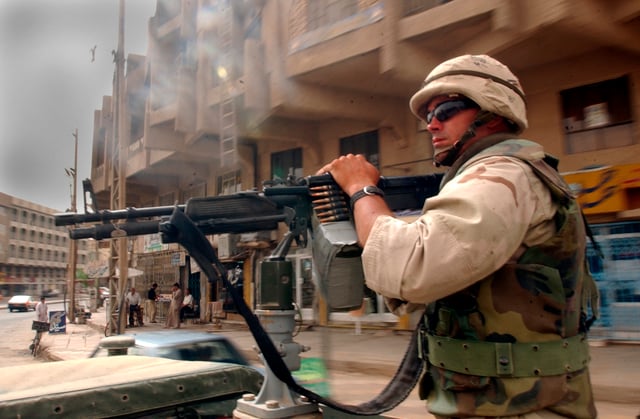
NMCB 15 Seabee mans a vehicle-mounted machine gun while travelling through Al Hillah, Iraq in May 2003 (U.S. Navy).
Seabees were deployed from the beginning of the invasion of Afghanistan in 2001 and Iraq in 2003. They provided the required construction skills to rebuild the infrastructure of both Afghanistan and Iraq. All active and reserve NMCBs and NCRs were deployed to get the job done.[211] NMCB 133 deployed to FOB Camp Rhino and Kandahar Airfield where a detention facitlty was constructed.[211] One of their most high-profile tasks in Iraq was the removal of statues of Saddam Hussein in Baghdad. In Afghanistan, the Seabees' main task was the construction of multiple forward operating bases for U.S. and coalition forces.[211]
Since 2002, Seabees have provided critical and tactical construction skills in an effort to win the hearts and minds of locals in the Philippines.[211] Their efforts have begun to deter the rising influence of radical terrorists in the southern Philippines, most notably the Abu Sayyaf's jungle training area. Seabees work along with Army, Marines, and Air Force under Joint Special Operations Task Force-Philippines.[211]
see Notes:
Disaster relief and recovery
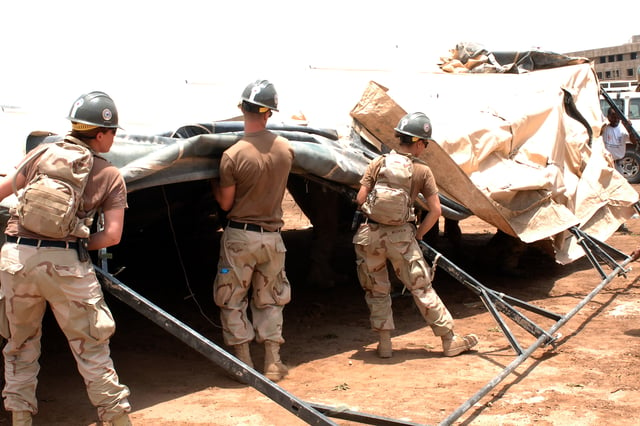
NMCB 5 attached to Combined Joint Task Force – Horn of Africa set up tents to house displaced victims of a devastating flood that hit Ethiopia. (U.S. Navy, 2006)
Hurricane Camille in 1969 made landfall 20 miles west of Naval Construction Battalion Center (Gulfport, Mississippi), NMCB-121 was in home port then, and was called upon for cleanup, rescue, and community outreach for months to come. They fed displaced families and supported the community.
Cyclone Ofa in 1990 – NMCB 133 sent a 100-man detachment to American Samoa to aid in the recovery.
1994 Northridge earthquake, Seabees supported disaster recovery efforts for victims.
Hurricane Andrew in 1992, Seabees were called on to provide recovery assistance for Homestead, Florida.[210]
Operation Restore Hope 1992–1993 Seabees were vital to the humanitarian efforts in Somalia sending two Battalions.[212]
Operation Sea Signal 1994 Seabees were called to provide assistance to the Haitian Relief effort at Guantanamo Bay Naval Base, Cuba.[210]
Operation Joint Endeavor On Christmas Day 1995, Seabees arrived in Croatia to support the Army by building camps as part of the peacekeeping effort in Sarajevo, Bosnia and Herzegovina. NMCB 40 played a pivotal role serving with the U.S. Army 1st Infantry Division "The Big Red One", in assisting with the dismantling of forward operating bases during the IFOR/SFOR phase.[210]
Hurricane Georges (Sept 1998) plowed through the Caribbean Islands, causing millions of dollars in damage, and generating thousands of disaster recovery team (DRT) man-hours for the Seabees. The Navy provided generators and water trucks that were taken to nearby cities, and damage assessment teams were sent to the local islands.
Hurricane Mitch The Seabees immediately turned their focus towards Mitch which was the most powerful hurricane of the 1998 season. Mitch left more than 17,000 people dead due to the high winds and heavy rains, which led to mudflows that buried thousands in Central America. The Seabees deployed to Honduras, participating in operations with Joint Task Force Bravo, providing capabilities to conduct engineer reconnaissance, repair roads and bridges, clear debris, remove bridges, and build base camps. NMCB 7 was the first Navy element to arrive in Central America, taking part in their second humanitarian mission on the deployment.
Hurricane Ivan Seabees deployed in September 2004 in response to destruction to the Naval Air Station Pensacola in Florida. The Seabees cleared hurricane debris, repaired roads, erected tents, and otherwise assisted fellow service members. NMCBs 1 & 74
Typhoon Nanmadol (2004) NMCB 7
2004 Indian Ocean earthquake and tsunami NMCBs 7, 40 and Underwater Construction Team (UCT) 2
Joint Task Force Katrina 2005. Seabees from NMCBs 1, 7, 18, 40 and 133 plus ACB 2 and CBMUs 202 and 303 and UCT 1 were tasked to rebuilding CBC Gulfport and the recovery of the Gulf Coast of the United States[213]
2010 Haiti earthquake Seabees of NMCB 7 deployed to provide construction support and disaster relief to Haiti as did Seabee divers from Underwater Construction Team One, ACB-2 and the Army Engineer divers. They made repairs to the heavily damaged port facilities in Port-au-Prince, enabling the re-opening of the port for humanitarian supplies reach the country.
April 2011 Miyagi earthquake Seabees from NMCB-133 and Underwater Construction Team Two deployed to Japan as part of the relief effort after the earthquake and tsunami. 2011 Tōhoku earthquake and tsunami
Seabees of NMCB 11 Air Detachment deployed for roughly two weeks to support federal, state, and local authorities in disaster recovery operations in the New Jersey and New York areas affected by Hurricane Sandy. The Air Detachment mounted out 90 personnel and 94 pieces of civil engineering support equipment including front-end loaders, backhoes, pumps, electric generators, storage containers, and other equipment which was convoyed to the disaster area.[214] 110 Seabees from NMCB 5 were also deployed to assist in disaster relief efforts, performing vital utilities work and clearing roads and debris throughout the Sandy Hook area.[215]
Combat Service Support Detachments (CSSD) / (NSW)
Combat Service Support Detachments (CSSD) have several hundred Seabees assigned in support of Naval Special Warfare (NSW) units based out of Coronado, CA, and Virginia Beach, VA. Seabees provide the field capabilities of power generation/distribution, logistical movement, vehicle repair, construction/maintenance of encampments, water purification or facilities.[216][217][218][219][220] Seabees assigned to support NSW receive extra training in first aid, small arms, driving, and specialized equipment.[216][218] and are expected to qualify as Expeditionary Warfare Specialists.[221][222] Seabees assigned to NSW are eligible to receive the following Naval Enlisted Classifications upon filling the requirements: 5306 – Naval Special Warfare (Combat Service Support) or 5307 – Naval Special Warfare (Combat Support).[223] They also can apply for selection to support the NSW Development Group.[224]
Naval Construction Force (NCF)
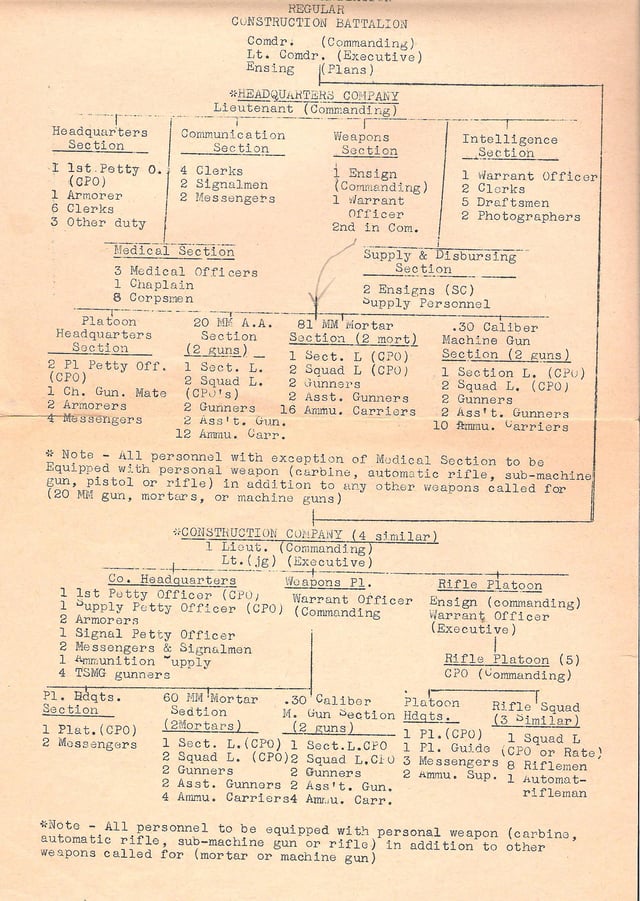
WWII Seabee Battalion Organization (Seabee Museum)
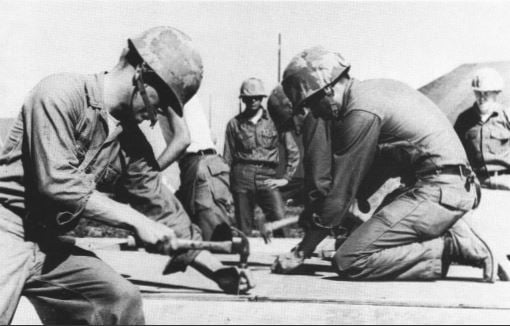
Builders fabricating a Strongback tent during a training exercise at Port Hueneme, 1969. (USN)
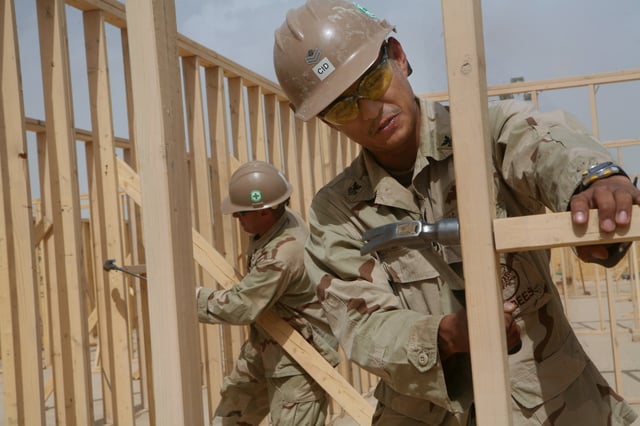
Seabee builders framing walls at Camp Leatherneck in Afghanistan in 2009 (USMC)
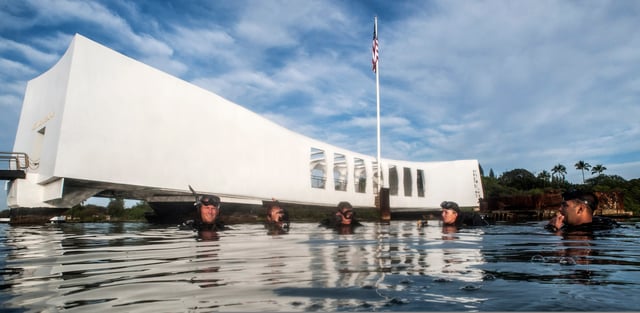
Underwater Construction Team 2 along with divers of the National Park Service make dives to ascertain the condition and status of the battleship USS Arizona Memorial at Pearl Harbor, Hawaii, March 21, 2013, USN 130321-N-WX059-135
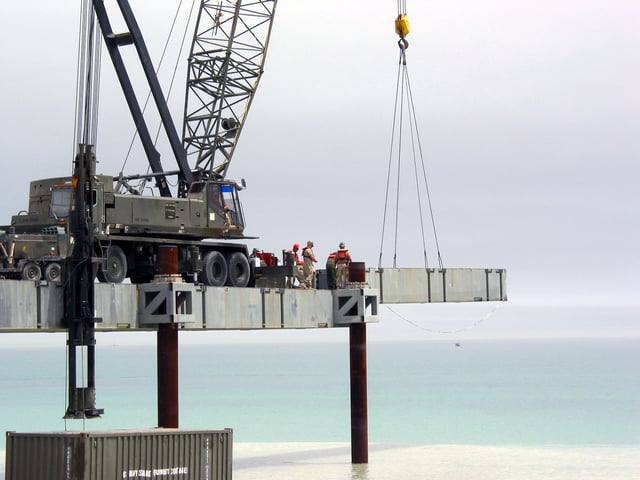
US Navy 030404-N-1050K-023U.S. Seabees from ACBs 1 and 2 place a deck section in the assembly of the Elevated Causeway System-Modular (ELCAS (M)) at Camp Patriot, Kuwait (Apr 4, 2003) It was the first time the ELCAS/M (length 1,400-feet) was assembled in a combat operation.[230]
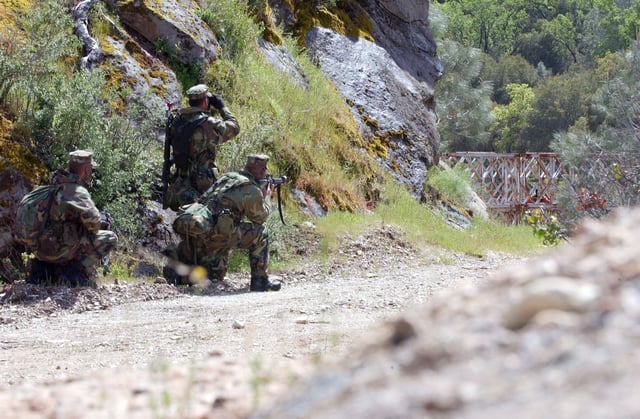
Seabee Engineer Reconnaissance Team from NMCB 40 making an assessment of a bridge to ascertain its ability to support movements during a field exercise. US Navy
At present, there are six active-duty Naval Mobile Construction Battalions (NMCBs) in the United States Navy, split between the Pacific Fleet and the Atlantic Fleet.
30th Naval Construction Regiment, Hq Guam – Pacific Fleet – Homeport for the Pacific Fleet Battalions is Port Hueneme, CA.
NMCB 3[225]
NMCB 4
NMCB 5
22nd Naval Construction Regiment, Hq Gulfport, Mississippi – Atlantic Fleet – Homeport for the Atlantic Fleet battalions is Gulfport MS.
NMCB 1[226]
NMCB 11
NMCB 133
Navy Expeditionary Combat Force, Naval Base San Diego
Construction Battalion Maintenance Unit 303
NCF Reserve
NMCB 14: Headquartered at NCBC Gulfport, MS. with detachments in South Carolina, Tennessee, Georgia, Florida, Alabama, and Puerto Rico.
NMCB 18: Headquartered at Naval Base Ventura County, CA. with detachments in Washington, Oregon, California, Idaho, and Utah and Nevada.
NMCB 22: Headquartered at Port Hueneme, CA. with detachments in Texas, Colorado, New Mexico and Oklahoma.
NMCB 25: Headquartered at Port Hueneme, CA with detachments in Minnesota, Wisconsin, Illinois, North Dakota, Iowa, and Michigan.
NMCB 27: Headquartered at Westover Air Reserve Base, Chicopee, Massachusetts with detachments in six New England States as well as upstate New York.
Battalion: The battalion is the basic unit of the Naval Construction Force (NCF). Seabee battalions are constituted in such a way as to be self-sustaining in the field. The nomenclature for NCF battalions has evolved over the years. During World War II, there were more than 140 battalions commissioned[16] (fig. 27). Since then, battalions have been activated and deactivated using WWII unit numbers.
Detachment: This is a construction crew that is sent to smaller construction projects "detached" from the battalion's "main body" deployment site. They tend to be self-contained construction units capable of independently completing the assigned project.
1942 to 1949: Naval Construction Battalion (NCB)
1949 to 1964: Mobile Construction Battalion (MCB)
1964 to present: Naval Mobile Construction Battalion (NMCB)
From the early 1960s through 1991, reserve battalions were designated as Reserve Naval Mobile Construction Battalions (RNMCBs). After 1991, the word "reserve" was dropped, signifying the integration of reserve units with the active units of the NCF.
Regiment: During the rapid build-up of the Seabees during World War II, the number of battalions in a given area increased and larger construction programs were undertaken. This necessitated a higher command echelon to plan, coordinate, and assign the work of several battalions in one area. As a result, Naval Construction Regiments (NCRs) were established in December 1942.[1] []
Brigades were the highest NCF command echelon, until early in the 21st Century. At that time, the last two brigades were the Second Naval Construction Brigade (2nd NCB) and the Third Naval Construction Brigade (3rd NCB). The 2nd NCB commanded Atlantic Fleet Seabee units and the 3rd NCB commanded Pacific Fleet Seabee units.
Both brigades were decommissioned in August 2002 and are no longer part of the NCF structure.
Division: Shortly after the commencement of the Global War on Terror, it was realized that a single command interface for global Seabee operations would be required. On August 9, 2002, the First Naval Construction Division (1NCD) was stood-up and commissioned at NAB Little Creek in Virginia. Since January 2006, 1NCD has been a subordinate unit of Navy Expeditionary Combat Command (NECC). First Naval Construction Division (1NCD) was decommissioned May 31, 2013. The 1NCD staff will be integrated into NECC. Some 1NCD functions have been transferred to the newly created Naval Construction Groups (NCGs) in Gulfport, Mississippi, and Port Hueneme, California, which are now the East and West Coast community for the NCF.[227]
Construction Battalion Maintenance Unit (CBMU): When first organized during World War II, these units consisted of approximately one fourth of the personnel of an NCB, and were intended to take over the maintenance of bases on which major construction had been completed. Today, CBMU's provide public works support at Naval Support Activities, Forward Operating Bases, and Fleet Hospital/Expeditionary Medical Facilities during wartime or contingency operations. They also provide disaster recovery support to Naval Regional Commanders in CONUS.
Underwater Construction Team (UCT):
"NAVFAC Engineering & Expeditionary Warfare Center Ocean Facilities Department supports the Fleet through the support it gives the Underwater Construction Teams".[228] UCTs deploy worldwide to conduct underwater construction, inspection, repair, and demolition operations of ocean facilities, to include repair of battle damage. They maintain a capability to support a Fleet Marine Force amphibious assault, subsequent combat service support ashore, and self-defense for their camp and facilities under construction. UCT1 is home ported at Virginia Beach, Virginia, while UCT2 is at Port Hueneme, California.
see MILPERSMAN 1306-912[229]
Naval Construction Groups: In 2013, the Seabee Readiness Groups (SRGs) were decommissioned, and re-formed into Naval Construction Groups One and Two. They are regimental-level command groups, tasked with administrative and tactical control of Seabee Battalions, as well as conducting pre-deployment training of NCF units in the NCGs' respective home port locations. Currently, Naval Construction Group Two (NCG-2) is based at CBC Gulfport, and Naval Construction Group One (NCG-1) is based at CBC Port Hueneme.
Amphibious Construction Battalion (ACB): [not NCF assigned]
ACBs (also abbreviated as PHIBCB) evolved out of pontoon assembly battalions formed as part of the Seabees during World War II. On 31 October 1950, MCBs 104 and 105 were re-designated ACB One and ACB Two, and assigned to Naval Beach Groups. Today, the ACBs are not part of the NCF, reporting to surface TYCOMs. Additionally, an ACB has a different personnel-mix to an NMCB, with half the enlisted personnel being traditional Seabee rates and the other half being fleet rates.
Public Works: U.S. Naval Bases: These units have CEC officers leading them and enlisted Seabees for the various crews. About one-third of new Seabees are assigned to Public Works Departments (PWD) at naval installations both within the United States and overseas. While stationed at a Public Works Department, a Seabee has the opportunity to get specialized training and extensive experience in one or more facets of their rating. Some bases have civilians that augment the Seabees, but the department is a military organization.
Seabee Engineering Reconnaissance Teams (SERTs)
Seabee Engineer Reconnaissance Teams are ten-person teams, developed during Operation Iraqi Freedom. SERTs are divided into three components: a liaison element, a security element and a reconnaissance element. The liaison (LNO) element has a CEC officer and two petty officers who are communications specialists. The LNO element is responsible for communications with higher echelons, both in transferring engineering assessments and intelligence and in receiving engineering reach-back solutions. The reconnaissance element has a CEC officer, who is the SERT Officer-in-Charge (OIC), a Builder or Steelworker chief petty officer who has some bridge construction experience, and petty officers of varying Seabee ratings. The OIC is normally a licensed professional engineer with a civil/structural engineering background. A SERT unit will include a corpsman or corpsman-trained member, with the rest of the team being selected from the best of their trades in their battalion. All are qualified Seabee Combat Warfare Specialists. The UCTs proved the SERT concept was viable and they have led the way to the concept's adoption throughout OIF.[231]
NCF unit types that no longer exist
Construction Battalion Detachment (CBD)
Construction Battalion Detachment Special (CBDS)
Construction Battalion Special (stevedores)
Construction Battalion Unit (CBU)
Naval Construction Division (NCD)
Naval Construction Force Support Unit (NCFSU)
Pontoon Assembly Detachments (PAD)
Seabee Readiness Groups (SRG)
Training and rates
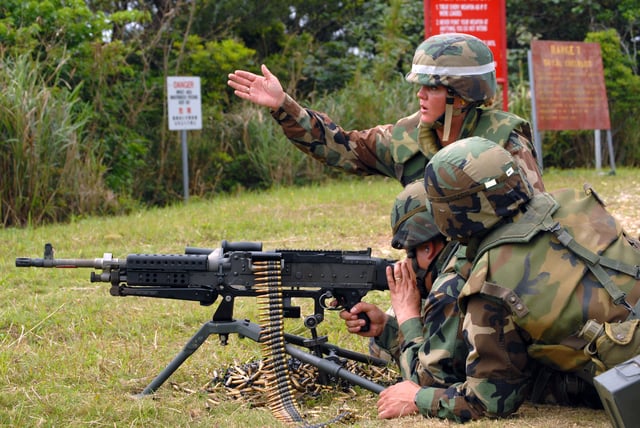
NMCB 3 Seabees training on a M240 at the Marine Corps gun range, Camp Hansen Okinawa . (USN)
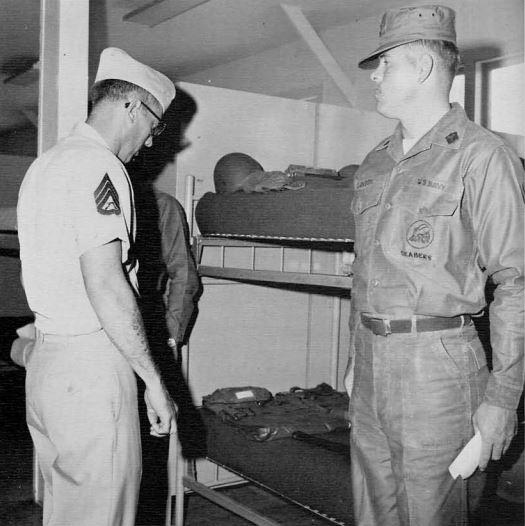
USMC barracks inspection during NMCB 74's military training at Camp Lejeune in March 1968 (USN)
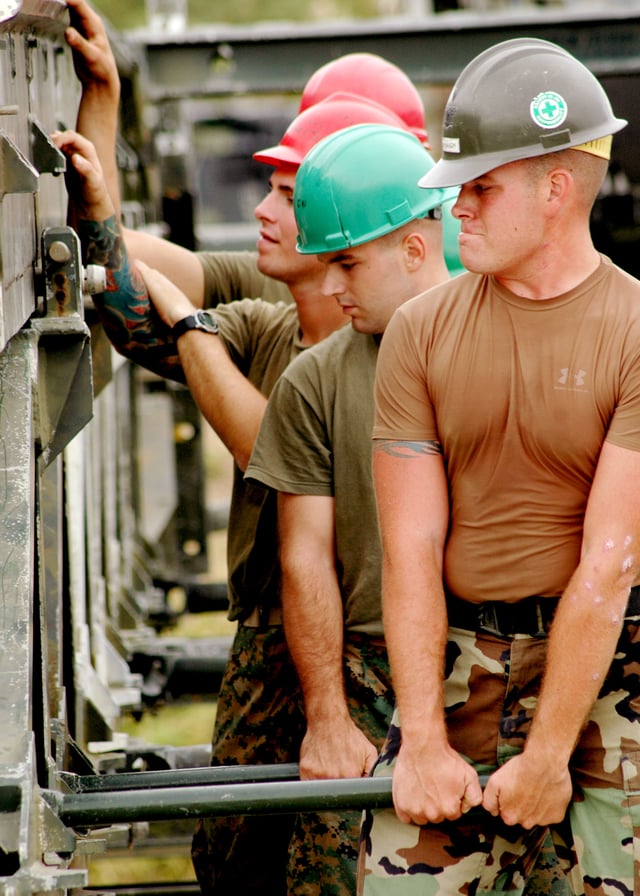
Seabees and Marines work together during a joint training exercise. (USN)

Diving Officer

2nd Class Diver

1st Class Diver
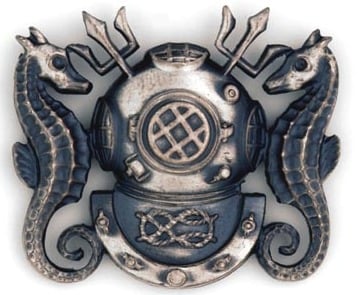
Master Diver
The newcomers begin "A" School (preliminary training) fresh out of boot camp, or they come from the fleet after their service term is met, spending about 75% of the twelve weeks immersed in hands-on training. The remaining 25% is spent in classroom instruction. From "A" School, new Seabees most often report to an NMCB command for their first tour of duty. For training, the new Seabees attend a four-week course of Expeditionary Combat Skills (ECS) at the Naval Construction Battalion Center in Gulfport, Mississippi, and Port Hueneme, California. ECS is also being taught to all personnel who report to a unit in the Navy Expeditionary Combat Command. ECS is a basic combat-skills course in learning map reading and land navigation, battlefield first aid, formulating defensive plans, conducting reconnaissance, and other combat-related skills. Half of each course is spent at a shooting range learning basic rifle-marksmanship and qualifying with a M16A2 or M16A3 rifle and the M9 service pistol. Those that are posted Alfa Company of an NMCB may be assigned to a crew-served weapon, such as the MK 19 40 mm grenade launcher, the M2HB .50-caliber machine gun, or the M240 machine gun. Many reserve units still field variants of the M60 machine gun. Until 2012, Seabees wore the U.S. Woodland camouflage uniform or the legacy tri-color Desert Camouflage Uniform, the last members of the entire U.S. military to do so, but have now transitioned to the Navy Working Uniform NWU Type III. Seabees use ALICE field gear, as well as some units working with Marines using USMC-issue Improved Load Bearing Equipment (ILBE) gear.
WWII training
Camp Endicott had roughly 45 different vocational schools plus additional specialized classes. These included Air compressors, Arc welding, BAR, Bridge building, Bulldozer operation, Camouflage, Carpentry, Concrete construction, Crane operation, Dam building, Diving, Diesel engines, Distillation and water purification, Dock building, Drafting, Drilling, Dry docks, Dynamite and demolition, Electricity, Electric motors, First aid, Fire fighting, Gasoline Engines, Generators, Grading roads and airfields, Ice makers, Ignition systems, Judo, Hut and tents, Lubrication, Machine gun, Marine engines, Marston Matting, Mosquito control, Photography, Pile driving, Pipe-fitting/plumbing, Pontoons, Power-shovel operation, Pumps, Radio, Refrigeration, Rifle, Riveting, Road building, Road Scrapers, Sheet metal, Soil testing, Steelworking, Storage tanks wood or steel, Tire repair, Tractor operation, Transformers, Vulcanizing, Water front, and Well-drilling.[234]
BMB : Boatswains Mate Seabee
CMCBB : Carpenters Mate Construction Battalion Builder
CMCBD : Carpenters Mate Construction Battalion Draftsman
CMCBE : Carpenters Mate Construction Battalion Excavation foreman
CMCBS : Carpenters Mate Construction Battalion Surveyor
EMCBC : Electricians Mate Construction Battalion Communications
EMCBD : Electricians Mate Construction Battalion Draftsman
EMCBG : Electricians Mate Construction Battalion General
EMCBL : Electricians Mate Construction Battalion Line and Station
GMCB : Gunners Mate Construction Battalion
GMCBG : Gunners Mate Construction Battalion Armorer
GMCBP : Gunners Mate Construction Battalion Powder-man
MMCBE : Machinists Mate Equipment Operator
SFCBB : Ship Fitter Construction Battalion Blacksmith
SFCBM : Ship Fitter Construction Battalion Draftsman
SFCBP : Ship Fitter Construction Battalion Pipe-fitter and Plumber
SFCBR : Ship Fitter Construction Battalion Rigger
SFCBS : Ship Fitter Construction Battalion Steelworker
SFCBW : Ship Fitter Construction Battalion Welder
DIVER: During WWII being a Navy diver (United States Navy) was not a "rate" it was a "qualification" that had four grades: Master, 1st Class, Salvage, and 2nd Class.[237] The Seabee diving schools[238] could only qualify divers 2nd class. Numerous CBs had men qualified: e.g. 21st[239] 27th,[240] 31st,[241] 34th (segregated)[242] 49th,[243] and CBMU 541 to name but a few.[244]
BU : Builder
CE : Construction Electrician
CM : Construction Mechanic
EA : Engineering aide
EO : Equipment operator
SW : Steelworker
UT : Utilitiesman
The Seabee ranks of E-1 through E-3 use the designation "Constructionman" and wear sky-blue stripes on their dress and service uniforms. This blue was adopted in 1899 as a uniform trim color designating the Civil Engineer Corps, but was later given up. Its use by the junior enlisted is a bit of Naval Heritage in the NCF.
At E9 the ratings are reduced to three: EQCM for equipment operators and construction mechanics, CUCM for builders, steelworkers and engineering aids, UCCM for construction electricians and utilitiesmen.
Diver : is a qualification that the various rates can obtain with three grades: Basic Underwater Construction Technician/ NEC 5932 (2nd Class Diver), Advanced Underwater Construction Technician/ NEC 5931 (1st Class Diver), and Master Underwater Construction Technician/ NEC 5933 (Master diver).[247] Seabee divers are attached to five principal commands outside the NCF:
UCT ONE, Little Creek, VA.[248]
UCT TWO, Port Hueneme, CA.[248]
Naval Facilities Engineering Service Center (NFESC) that has detachments in Port Hueneme, CA, and in the Washington Navy Yard, DC. These are CEC officer billets only. Those at Port Hueneme are with the highly technical NFESC "Dive Locker Team".[249]
Navy System Commands, e.g., NAVSEA or NAVAIR. These are CEC officer billets only.[248]
NEDU/NDSTC (Navy Experimental Diving Unit – Navy Diving & Salvage Training Center)[248]
The "Seabee" and CB unit insignias
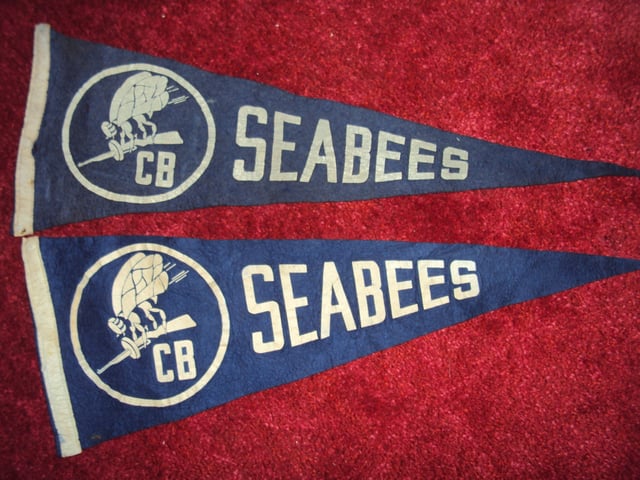
Seabee Logo Pennants early 1942. First pattern CB (drawn to be used as an identification stencil per BuDocks order not for uniforms).
On 1 March 1942 the Chief of BuDocks recommended that as a means to promote esprit de corps in the new branch of construction battalions, that an insignia be created for use on equipment similar to what air squadrons used on their aircraft (Fig. 26). This was not something for the uniform.[1] [] Frank J. Iafrate, a civilian plan file clerk at Quonset Point Advance Naval Base, Davisville, Rhode Island, was the artist who designed the original "Disney Style" Seabee in early 1942 with a large capital letter Q around the edge as border. This design was sent to Admiral Moreell who made a single request: that this reference to Quonset Point be changed to a hawser rope and it would be officially adopted.[250] That design remains in use to this day, predominantly unchanged. In late 1942, after designing the logo, Iafrate enlisted in the Seabees.[251] The Camp Post exchanges (PXs) sold pennants with a different Seabee design on them, that was stylistically similar to the Mosquito boat rating insignia.
The Seabees also had a second Logo that much less has been written about (Fig. 9). It was that of a shirtless construction worker holding a sledge hammer with a rifle strapped across his back standing upon the words "Construimus Batuimus USN". The figure is typically on a shield with a blue field across the top and vertical red and white stripes. A small CEC logo is left of the figure and a small anchor is to the right. The Camp's PXs sold two versions of brass badges with this logo, enameled or non-enameled. Despite little being written about this logo it is incorporated into many CB Unit insignias (or variations of it). A partial list of these CBs would be: 9, 15, 17, 23, 29, 41, 45, 50, 68, 75, 77, 86, 87, 90, 93, 95, 99, 143, 145 & 18th Special, Construction Battalion Units (CBUs) 408, 504, 535 and the 7th Brigade.[252] Other units simply used it like 133 NCB did on the front cover of their unit history the "Rain Makers Log".[253]
During World War II, artists working for Walt Disney in the Insignia Department designed logos for about ten Naval Construction units, including the 60th NCB,[254] the 78th NCB[254] the 112th NCB[255] and the 133rd NCB.[253] There are two Seabee logos in the book on WWII Disney insignia entitled "Disney Don's Dogtags" that are not identified with any unit. Disney did not create the original Seabee insignia.
The end of WWII brought the decommissioning of nearly every Seabee Battalion. The Construction Battalions had been in existence less than four years when this happened and the Navy had not created a Historical Branch or Archive for the NCF. So, there was no central record of the Seabees history or archive for the insignia of the individual units. As history passed, first with Korea and then Vietnam, Construction Battalions were reactivated with the units having no idea what the WWII insignia had been so they made new ones, NMCB One has had three. NMCB 8 is the exception. That Battalion has an insignia very similar to what it had during WWII.
Seabee Combat Warfare Insignia and Peltier Award

SCW insignia: officer and enlisted

Fleet Marine Force insignia authorized for US Naval personnel: Officer, Enlisted, and Chaplain
The military qualification badge for the Seabees is known as the Seabee combat warfare specialist insignia (SCW). It was created in 1993 for issue to both officers and enlisted personnel that fulfill the training requirements. Only members attached to a qualifying NCF unit are eligible for the SCW pin. The qualifying units include: Naval Mobile Construction Battalions (NMCB), Amphibious Construction Battalions (ACB), Naval Construction Force Support Units (NCFSU), Underwater Construction Teams (UCT), and, since the end of 2008, Naval Construction Regiments (NCR).
The Fleet Marine Force Insignia, also known as the Fleet Marine Force pin or FMF pin, are three military badges of the United States Navy which are issued to those U.S. Navy officers and sailors who are trained and qualified to perform duties in support of the United States Marine Corps. Those Seabees that draw an assignment with the Fleet Marine Force can earn the Fleet Marine Force Insignia, also known as the Fleet Marine Force pin or FMF pin. the United States Navy has authorized these badges for U.S. Navy officers and sailors who are trained and qualified to perform duties in support of the United States Marine Corps. There are currently three classes of the Fleet Marine Force pin: enlisted, officer, and chaplain. For the requirements, see: Fleet Marine Force Warfare Specialist (EFMFWS) Program per OPNAV Instruction 1414.4B.
The Peltier Award is given to the "best of type" active duty Naval Construction Battalions. It was instituted by Rear Admiral Eugene J. Peltier CEC and has been given annually since 1960. He is a former head of the Bureau of Yards and Docks (1959–1962).
WWII U.S.N. CB awards for valor were listed each month in All Hands along with the rest of the Navy.[260]
Seabee barge carriers
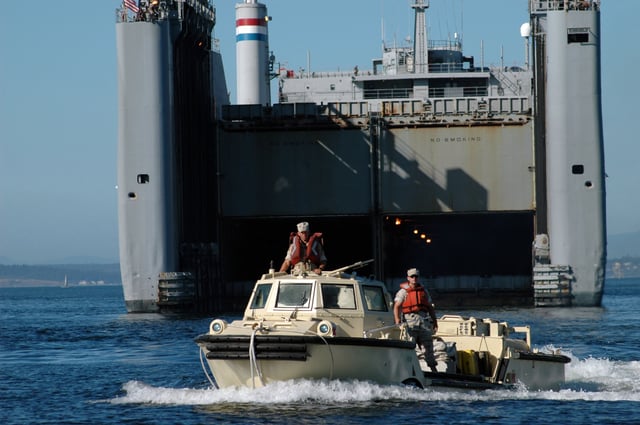
US Navy 050728-N-8268B-022 A Logistical Amphibious Recovery Craft (LARC) amphibious vehicle assigned to Beachmaster Unit One (BMU-1) launches from the Military Sealift Command (MSC) sea barge heavy lift ship SS Cape Mohican (T-AKR-5065)
see: Seabee (barge)
The first ship of a series of six "Seabee" ships,[261] was the SS Cape Mendocino (T-AKR-5064), followed by SS Cape May (T-AKR-5063) and SS Cape Mohican (T-AKR-5065) (Fig. 37), three of which were operated by Lykes Brothers Steamship Company. "The U.S. Navy's Naval Construction Force, or SeaBees, primarily use the Seabee barges. The barges are loaded with cargo and floated to and from a mother ship, which allows loading and unloading of containerized cargo off-shore. Seabee barge ships are equipped with a stern cargo elevator for loading the barges from the water onto the vessel; loaded barges can then be moved toward the vessel's bow using an internal track system. The barges are stowed on internal decks and are not stacked. The "Sea Bee" vessels had three decks and could transport 38 lighters (12 on the lower decks and 14 on the upper deck). Seabee barges are larger and heavier than their counterpart, LASH barges."[262] The dual function of the ship is noteworthy, as it had storage tanks with a capacity of nearly 36000 m³ volume built into its sides and unusually large double hull, allowing it to be used also as a product tanker. The ships were later purchased by Military Sealift Command.
Museums
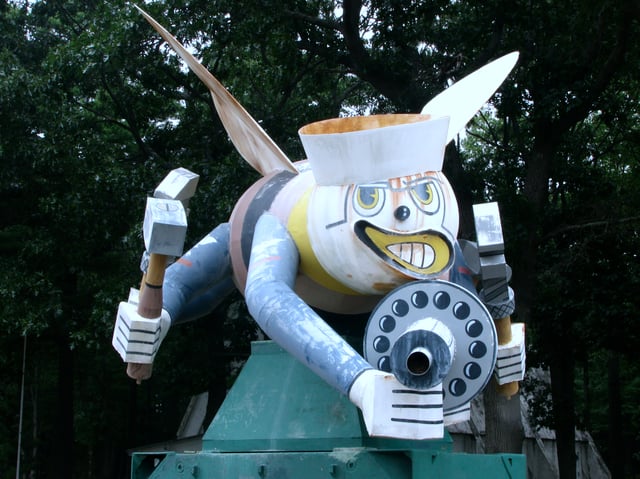
The Fighting Seabee Statue at Quonset Point, where the Seabee Museum and Memorial Park commemorates Camp Endicott which is on the National Register of Historic Places (U.S. Navy)
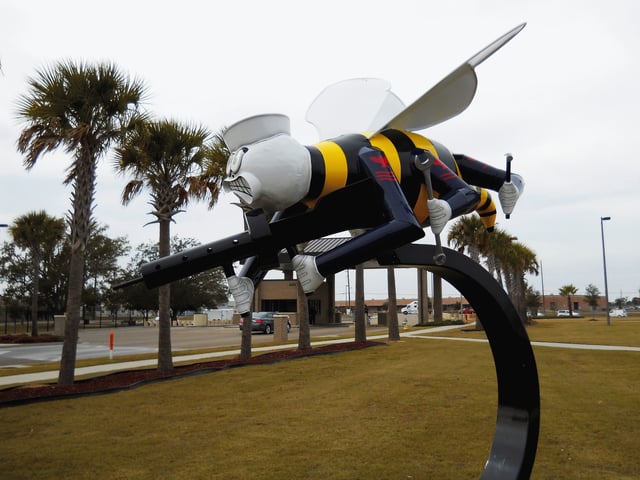
Fighting Seabee Statue designed by Seabee Architect L.J. Atkison in 1965. Originally designed for a Mardi Gras parade, it was retired to a statue in 1966 at Gulfport, Mississippi, (U.S. Navy)
The U.S. Navy Seabee Museum[263] is located at Naval Base Ventura County, Port Hueneme, California near the entrance, but outside the main gate. Due to the location, visitors are able to visit the museum without having to enter the base proper. The museum re-opened on 22 July 2011 in a new building built by Carlsbad-based RQ Construction. The design of the single-story, 38,833 square foot structure was inspired by the Seabee Quonset hut. Inside are galleries for exhibition space, a grand hall, a theater for 45 people, collections storage, and research areas.
On 7 February 2011, the museum was certified as LEED Silver for utilizing a number of sustainable design and construction strategies. Features include the use of low-maintenance landscaping; a "cool" roofing system with high solar reflectance and thermal emittance; use of photocell-controlled light fixtures and energy-efficient lighting fixtures; 30% use of regional materials and 80% construction debris was recycled and diverted from landfills; low-volatility organic compounds (VOCs); and, use of dual-flush toilets and low-flow aerator faucets.
The Seabee Heritage Center is located in Building 446 at the Naval Construction Battalion Center. The Heritage Center is the Atlantic Coast Annex of the Seabee Museum in Port Hueneme.[264] Opened in 1995, the museum annex commemorates the history and achievements of the Atlantic Coast Naval Construction Force (Seabees) and the Navy's Civil Engineer Corps.[265] Exhibits at the Gulfport Annex are provided by the Seabee Museum in Port Hueneme.[266]
The Seabee Museum and Memorial Park[267] in Davisville, Rhode Island was opened in the late 1990s by a group of former Seabees. The Fighting Seabee Statue is located there.
Notable Seabees
Admiral Ben Moreell[268]
Glenn Corbett, actor.
Bruce Goff, architect.
Eric Flemming Actor (Gil Favor in Rawhide TV Series.)
Elmore Leonard, novelist and screenwriter.
William Levitt, real-estate developer. (COMCBLANT)
Lou Santiago, Host of Spike TV's MuscleCar.
Jame F. Sasseville, Cartoonist and ghost artist for Charle's Schultz's Snoopy cartoon[271] (MCB 9)
Marvin Glenn Shields, awarded Medal of Honor in Vietnam. (MCB 11)
Robert Stethem, murdered during hijacking of TWA Flight 847. (UCT 1)
Job Tate, legislator Vermont.
Battalions reactivated since WWII and decommissioned again:
NMCB 2: Commissioned 15 September 1950, decommissioned August 1956
NMCB 6: Commissioned 15 April 1951, decommissioned 17 November 1969
NMCB 7: Commissioned 15 August 1951, decommissioned August 1970, reactivated July 1985, decommissioned 5 September 2012
NMCB 8: Commissioned 10 September 1951, decommissioned 20 December 1969
NMCB 9: Commissioned 15 April 1952, decommissioned 17 November 1969
NMCB 10: Commissioned 2 October 1952, decommissioned June 1976 (Originally 103 NCB)
NMCB 12: Headquartered at Davisville, Rhode Island, decommissioned September 1992
NMCB 13: Headquartered at Camp Smith (New York), decommissioned September 1994
NMCB 15: Headquartered at Belton, Missouri, detachments in Missouri, Kansas, Iowa, Nebraska, and South Dakota, decommissioned September 2013
NMCB 16: Headquartered at Los Alamitos, California, detachments in California, Arizona, and Nevada, decommissioned September 1994
NMCB 17: Headquartered at Fort Carson, Colorado detachments in California, Arizona, Nevada, New Mexico, Colorado, Utah and Hawaii, decommissioned 18 September 2014
NMCB 20: Headquartered at Rickenbacker Air National Guard Base, Columbus, OH, decommissioned September 1994
NMCB 21: Headquartered at Lakehurst, New Jersey detachments in New Jersey, Pennsylvania, and Delaware, decommissioned 21 September 2013
NMCB 23: Headquartered at Fort Belvoir, Virginia, decommissioned 30 September 2013
NMCB 24: Headquartered at Red Stone Arsenal, Huntsville, Alabama, decommissioned 15 September 2013
NMCB 26: Headquartered at Selfridge Air National Guard Base Mt. Clemens, Michigan, detachments in Michigan, Ohio, Indiana, and Illinois, decommissioned 30 September 2014
NMCB 28: Headquartered at Barksdale Air Force Base, Louisiana, detachments in Arkansas, Louisiana, Mississippi, Missouri, Oklahoma, Tennessee, and Texas, decommissioned 2014
NMCB 40: Established 1 February 1966, decommissioned 12 September 2012
NMCB 53: Commissioned 30 June 1967, disestablished 19 December 1969
NMCB 58: Commissioned 15 March 1966, decommissioned 17 November 1969
NMCB 62: Commissioned 2 July 1966, decommissioned 28 July 1989
NMCB 71: Commissioned 4 October 1966, decommissioned 1 July 1975
NMCB 74: Commissioned 3 December 1966, decommissioned 2014
NMCB 121: Commissioned 4 February 1967, decommissioned 31 August 1970
NMCB 128: Commissioned 1 April 1967, decommissioned 17 November 1969
CBMU 302 reactivated Sept 1968, decommissioned 1994




